Hammond and the Age of Airships
Introduction
It may be hard to imagine today, but about 100 years ago, it was unclear whether the airplane or the airship would be the dominant form of air travel. John Hays Hammond Jr. supported both forms of transport, but his involvement with airships is of particular note. The following article details the history of airships in general, including their development, rise, and fall, and the role that our Museum’s founder briefly played in that story in the 1920s.
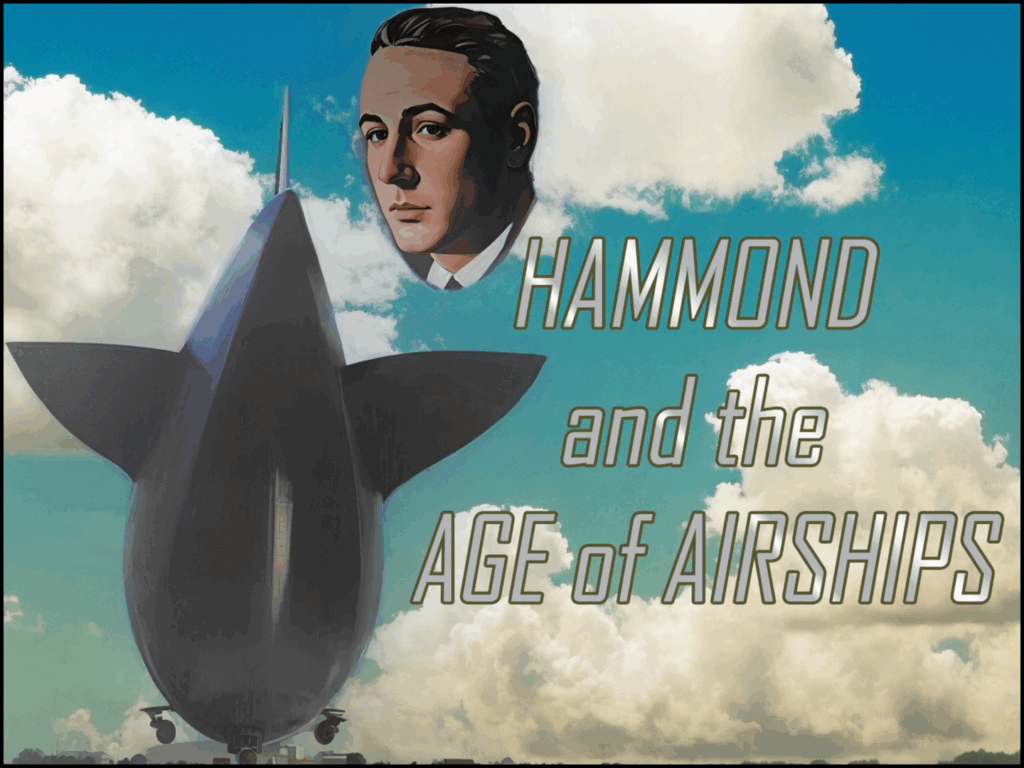
Lighter-Than-Air
For centuries before their actual invention, scientists such as Leonardo da Vinci conceived of flying machines that would enable humankind to take to the skies.
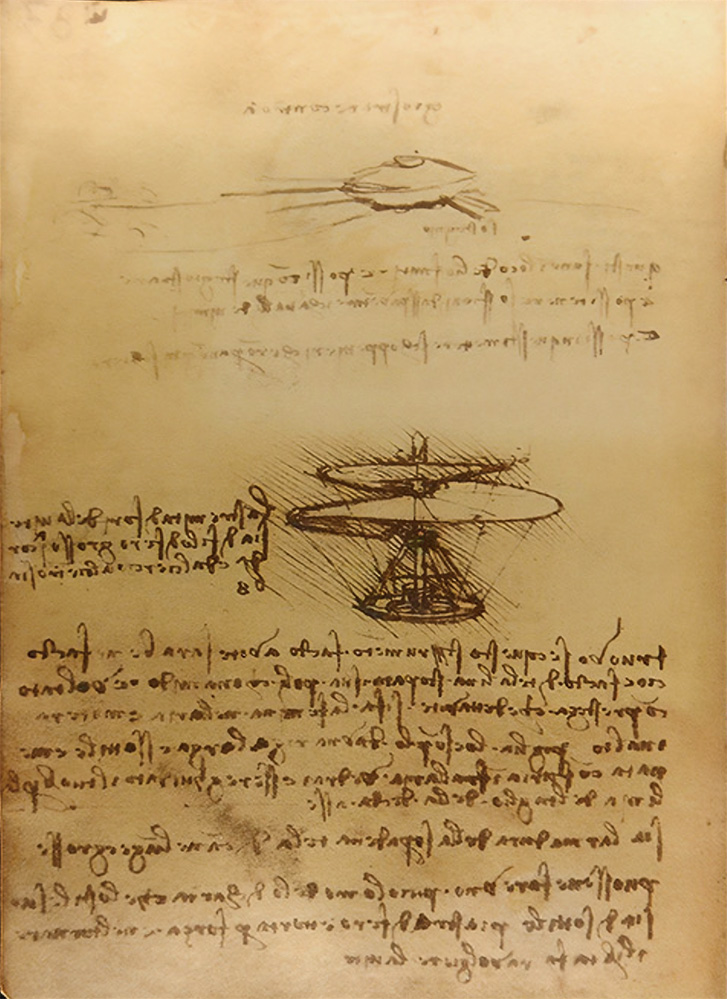
The concept of airships, as we would recognize them, dates back as far as 1663. In that year, Francesco Lana de Terzi, an Italian Jesuit priest and scientist, conceived of a flying boat that involved the use of sails and copper foil spheres that would pump out air and create a vacuum inside to allow for lighter-than-air travel. The technology to manufacture such a craft did not exist in de Terzi’s time, however, and the principle of its operation would have been impractical or impossible in practice. Still, it represents the beginning of a plausible concept for an airship, and presciently, the priest speculated that such a machine could be used as a weapon of war.

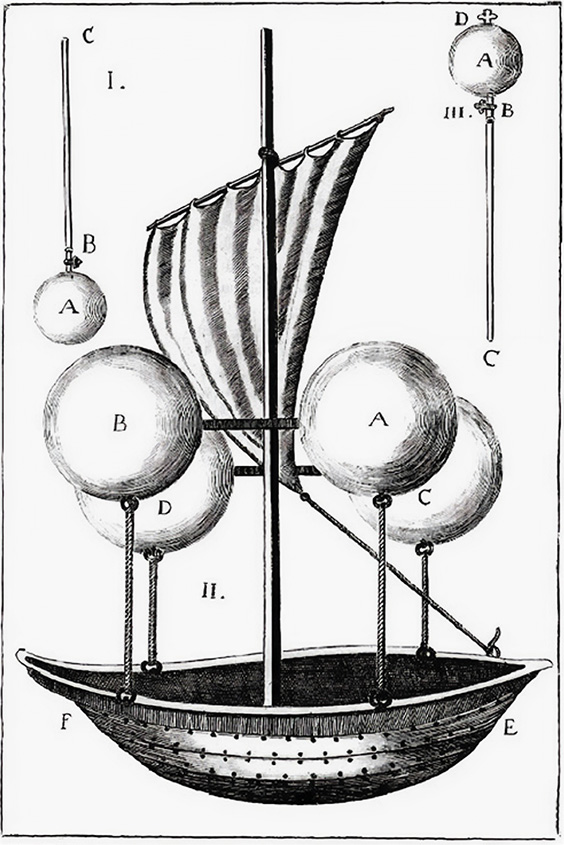
Francesco Lana de Terzi was not the only priest to turn his imagination to the problem of lighter-than-air travel during the Age of Exploration. In 1709, Bartolomeu Lourenço de Gusmão, a Brazilian priest, solicited funding from Portugal’s king to develop an airship that would have been held aloft by a bellows system. However, like de Terzi’s craft, this proposed airship never took off.
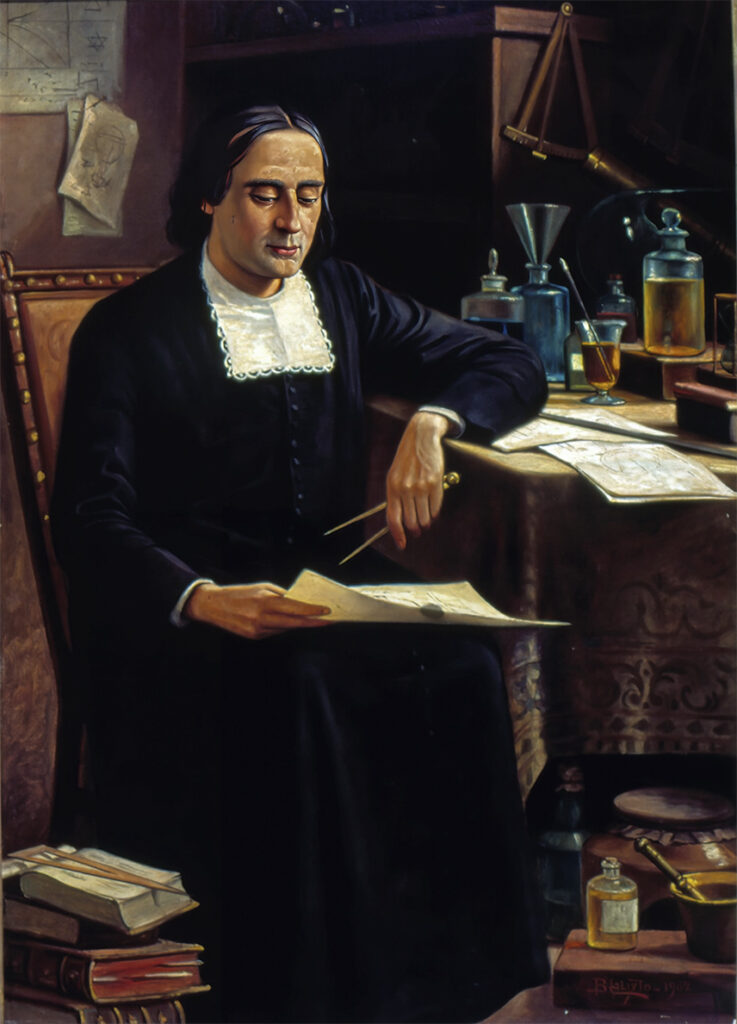
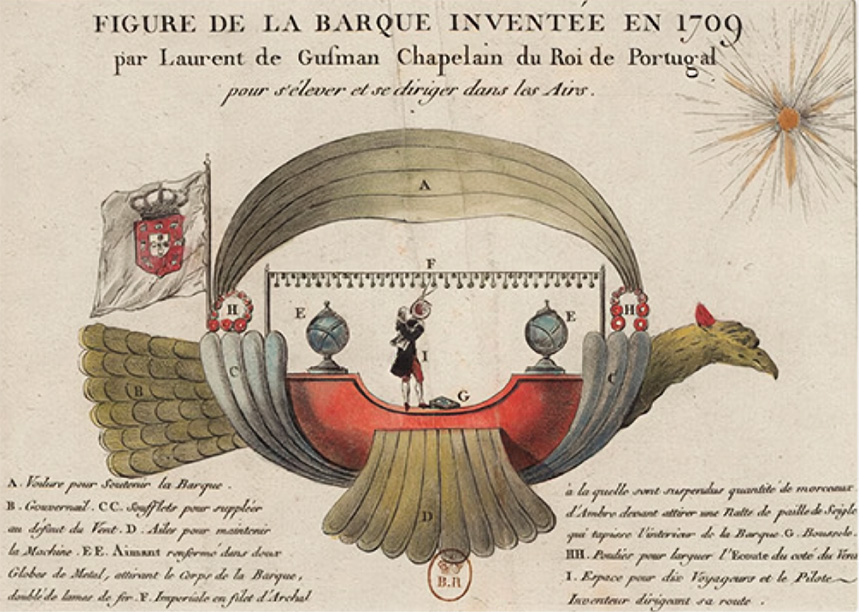
It wasn’t until 1782 that Joseph-Michel and Jacques-Étienne Montgolfier of France first demonstrated the principle that made lighter-than-air travel possible. The Montgolfier brothers, sons of a wealthy paper factory magnate, discovered that when hot air was enveloped by a paper or cloth bag, it could rise above the ground. This paved the way for a series of experiments with “fire balloons,” later known as hot air balloons, that enabled humans to fly for the first time in recorded history on November 21, 1783.

Credit for the most significant early work on the airship is shared between engineers in France and Germany. The first successful airship that used a lighter-than-air gas, hydrogen, was a French invention. Built by Henri Giffard in 1852, this craft used a steam engine to rotate a propeller as a means of propulsion. Twenty years later, German engineers made further progress on the airship when Paul Haenlein replaced the steam engine used by Giffard with an internal combustion version. Not to be outdone, Albert and Gaston Tissandier of France accomplished the same feat with an electric motor in 1883.


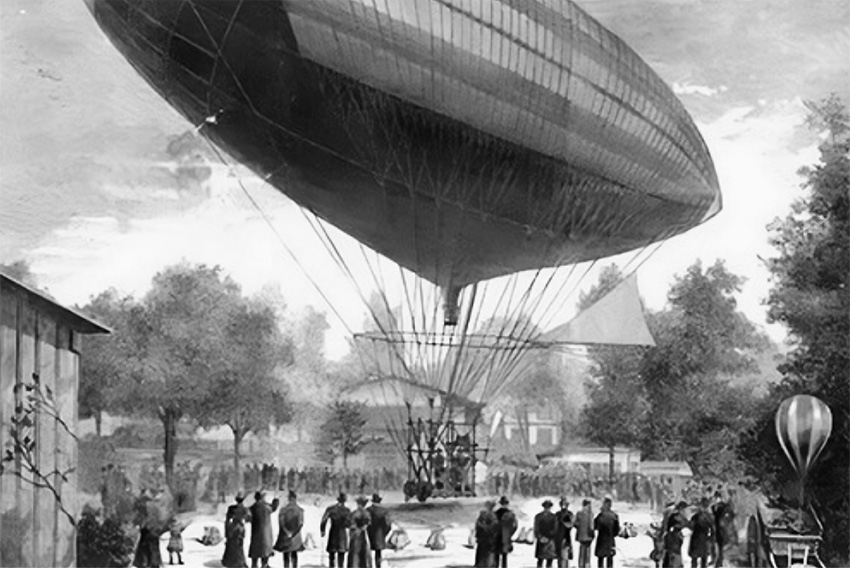
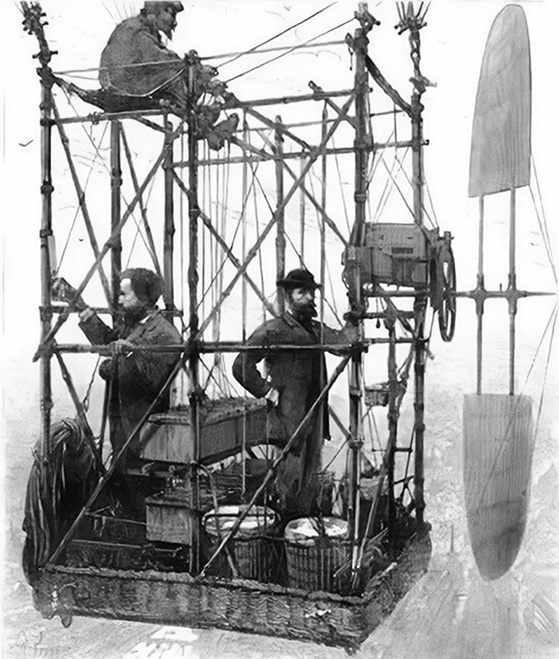
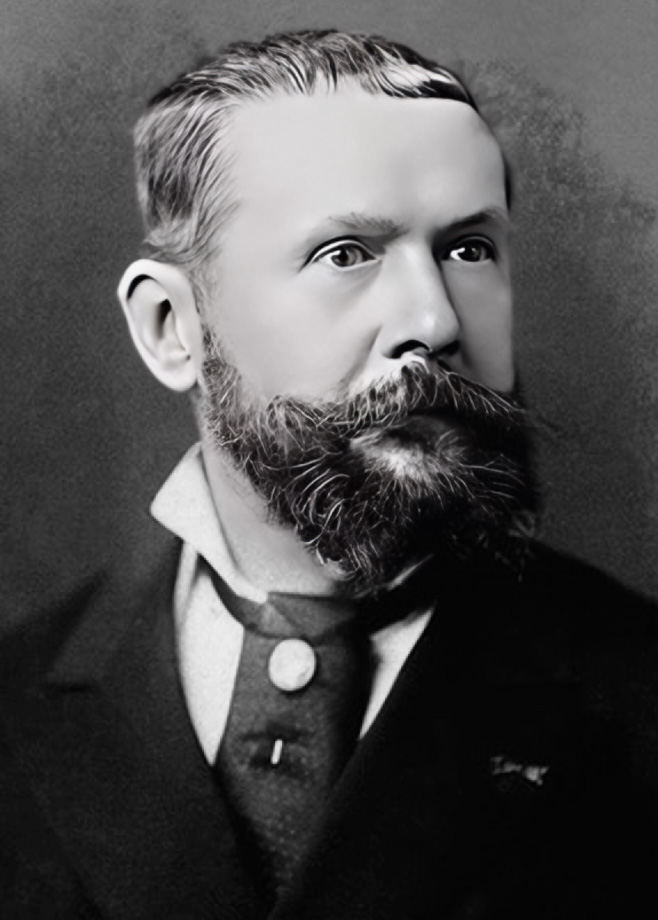
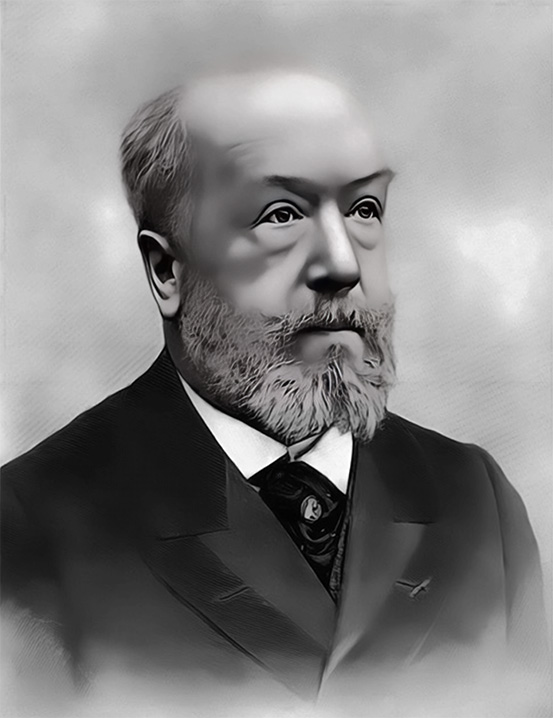

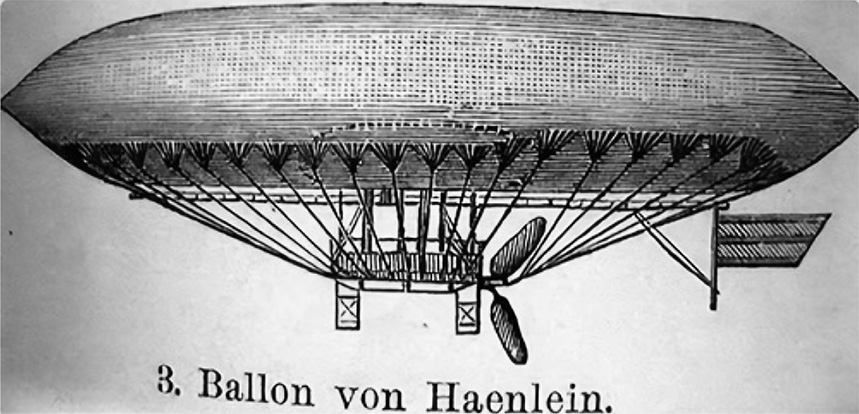
All of the ships described so far were what would later be called nonrigid airships, more commonly known as blimps. However, these types of vessels had limitations. For example, the bags that contained the lifting gas were single-celled, meaning that if they were to be damaged, the entire craft would fail, like popping a balloon. In addition, as the amount of weight an airship or balloon can carry is largely determined by the size of the craft and the volume of lifting gas that it can hold, if this mode of transport was to be practical, new designs would be needed to allow for larger envelope sizes.
The solution to the problem was the rigid type airship, first built in Germany in 1897. This used an internal structure of frames, girders, and lattices made out of light metals such as aluminum to contain multiple gas-filled cells. This provided a measure of redundancy; in this system, if one or more cells were damaged, the ship still had the chance to make a safe landing by relying on the intact cell(s).
The most successful rigid airships were built by the Zeppelin Company, founded by Count Ferdinand Von Zeppelin. His first ship, the LZ-1, was completed in 1900. Zeppelin’s name became synonymous with airships, and the company continued to produce successful ships through the period of the First World War, many of which would be used by Germany for military purposes.

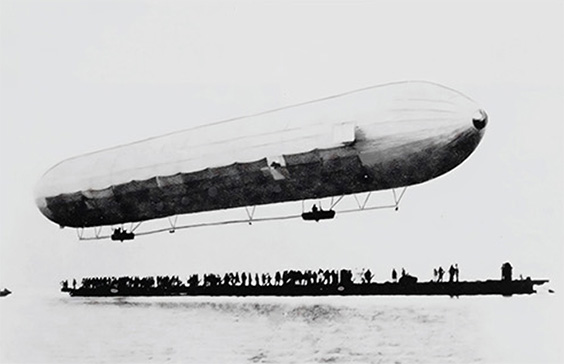
The Great War
Because of their military utility as well as their potential for civilian transportation, the Allies entered the industry during the WWI era. The United Kingdom and the United States both experimented with building airships at this time, with the former having greater success than the latter. The UK would go on to build 16 airships of its own, pioneering the B-class airship, a nonrigid or blimp type. This was superior to the US’s dismal first design, the DN-1.
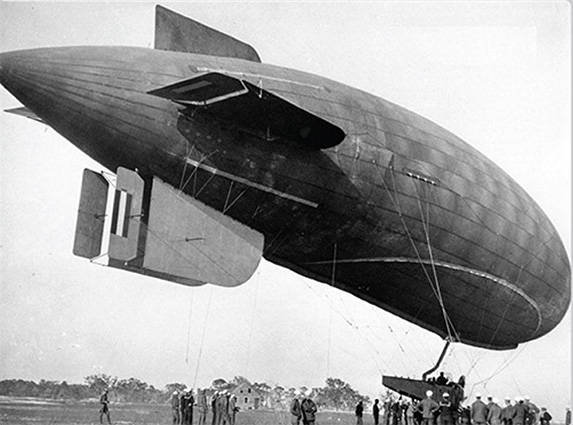
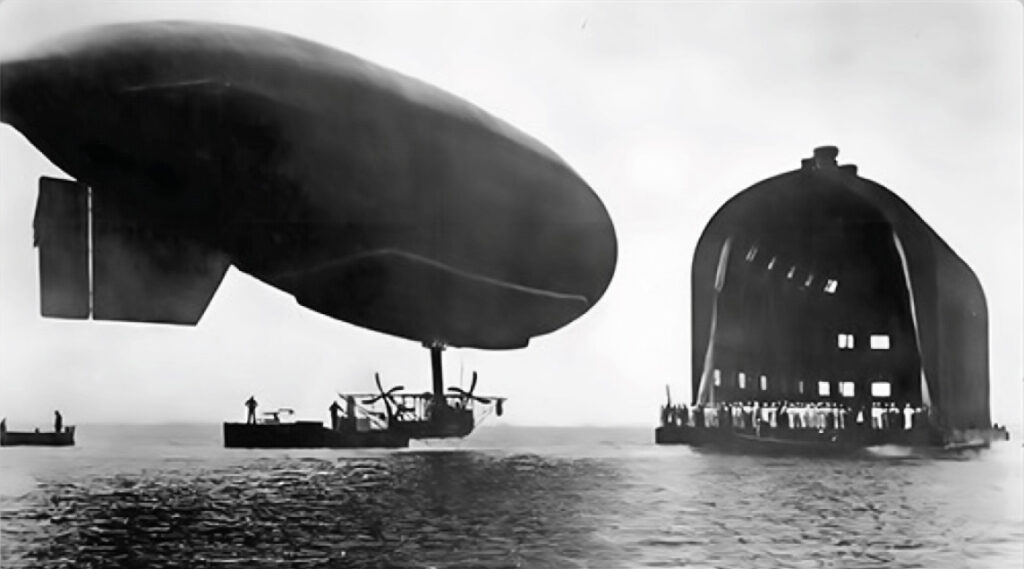
The US and the UK eventually collaborated in developing airship units in the latter nation. It was at this time that familiar names such as Goodyear and B.F. Goodrich entered the world of airships, alongside Curtiss, the airplane manufacturer that created the R-4 airplane used by John Hays Hammond Jr. for radio-guided torpedo experiments.
The First World War was a transformative event for the United States, which did not at this time have a proper air force. The flying craft that the nation did have access to were under the domain of the Army and Navy, and few in number. The US had a slow start to aeronautical research and development as compared with the major European powers such as France and Germany. If it wanted to be a major player on the world stage itself, the US needed to address this deficiency and look to the skies.
As predicted by John Hays Hammond Jr. in 1914, Germany began using its Zeppelins for war, bombing Allied targets in France and the United Kingdom. It was realized, even before the entry of the Americans into the conflict in 1917, that there was a need for better preparedness in view of this new military threat.
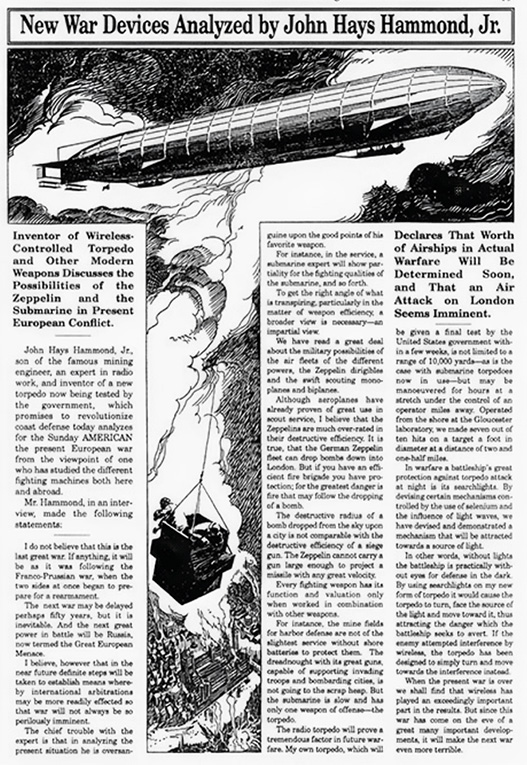
Hitherto, airships had used hydrogen as a lifting agent. It was effective, abundant, and cheap, but it also had a potential drawback: it was highly flammable. Recognizing this danger, the use of helium as an alternative lifting gas was proposed as early as 1914 in Britain. Later, in 1917, the US Bureau of Mines began a project to extract helium from a large deposit discovered in Texas.
The predominant threat to the Allies in the war was unrestricted submarine warfare. This is the reason why Hammond’s plan for coastal defense, Proposal Z, was so important to the Navy, and why airships became studied more heavily. As Great Britain would demonstrate, airships were uniquely suited to antisubmarine patrols. They possessed the ability to “loiter” in the air, making it more likely that their crews might spot the relatively tiny periscope of a German U-boat as it popped up from the ocean’s surface after long idle periods under the water. While the British B-class ships were not extensively used in combat, they did provide a strong countermeasure to the U-boat, and were deployed along the East Coast of the United States. In return, American naval personnel were sent to train with their Allied counterparts in this new technology.

Taking Flight
In the aftermath of the First World War, naval aeronautics research and development in the United States was divided between airplanes, seaplanes, balloons, and airships. This led to competition among the different branches for shares of finite budgets, and the airship got the smallest slice of the pie. Zeppelin-style rigid airships were almost an afterthought to the US Navy during the interwar period. The growth of the US naval air forces had grown rapidly, from virtually nothing to 7,000 Navy and Marine Corps officers, more than 2,000 airplanes, 15 blimps, and 215 balloons. However, it did not possess a single rigid airship.
The US had been entirely reliant on Allied sources of information regarding airship technology, some of which had been obtained from downed German craft. The British airship R-34 made the first transatlantic round trip flight in 1919. Without German know-how, the US would continue to lag behind its friends and rivals alike in the domain of air.
In June and July of 1919, surrendered German warships were scuttled as part of its postwar disarmament; in retaliation, a group of German loyalists sabotaged seven of its airships to prevent their use by the Allies. In response to this, the Allies demanded either replacement ships or their cash equivalent. These events laid the groundwork for the future production of civilian dirigibles, although the London Protocol negotiated following the war placed strict limits on the size of any such airships for fear of them being converted for military use.
Germany was punished most severely in the Treaty of Versailles that ended the Great War. As part of this agreement, the country’s fleet of airships was distributed among the Allied powers through 1920-1921. Britain, France, Italy, Belgium, and Japan all received airships; the United States received none, as it had failed to ratify the treaty.

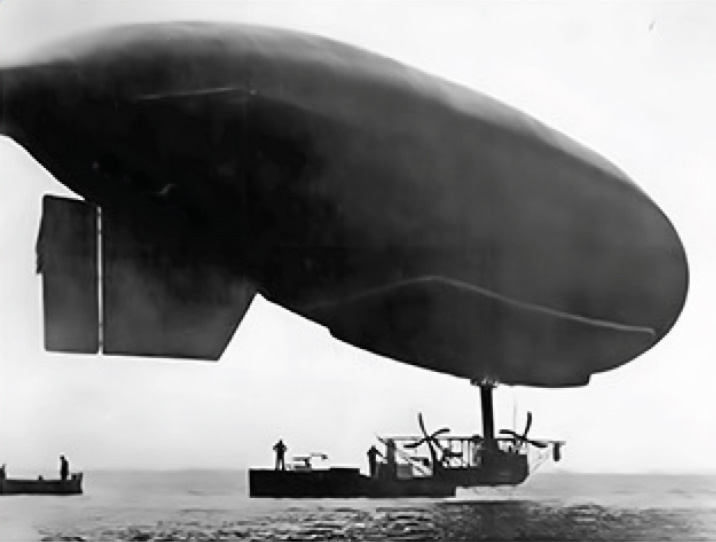
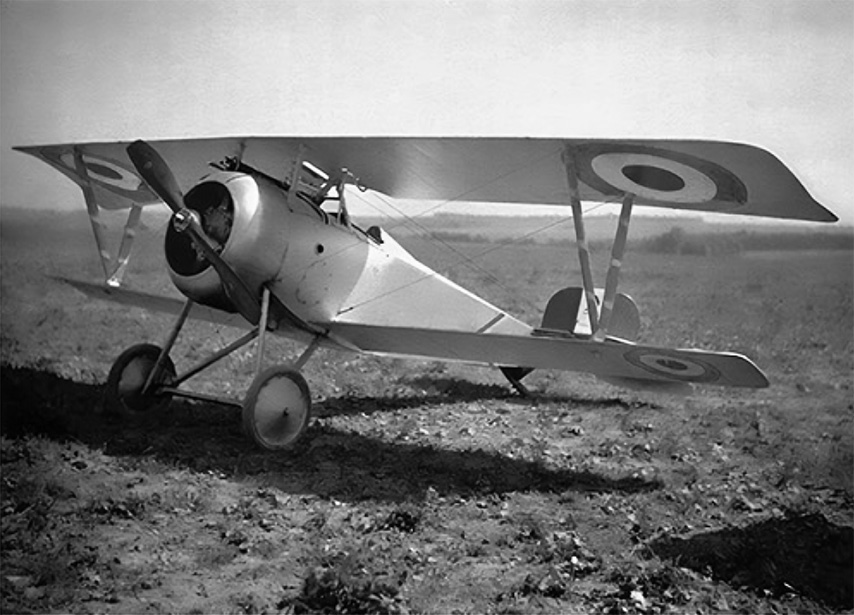
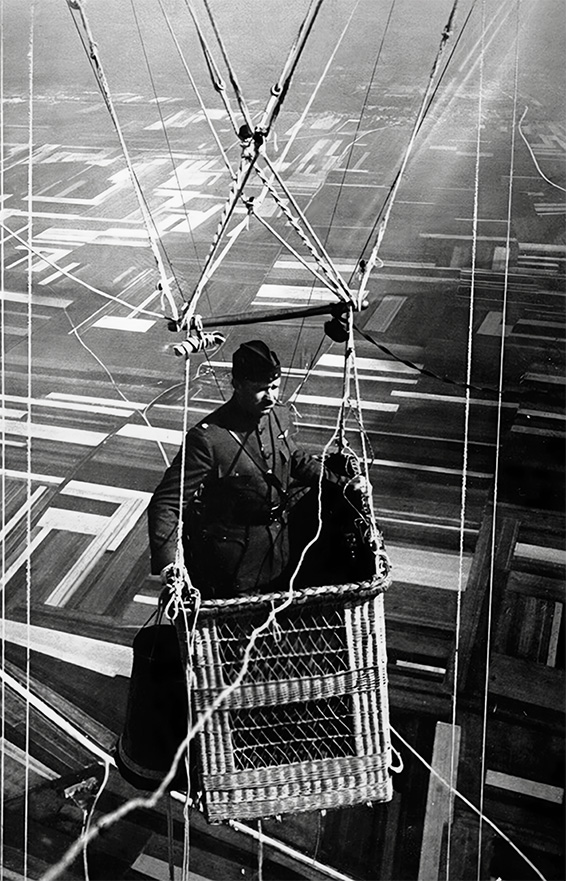
Nonetheless, the US maintained an interest in the technology of airships, and a variety of clandestine operations took place to investigate them in Germany. One example of such efforts was the American Investigation Corporation, an organization composed of and funded by many prominent businessmen and public officials of the day, including luminaries such as Franklin Delano Roosevelt. Its explicit goal was to investigate and develop airships for commercial purposes.
A key figure in airship history was Dr. Hugo Eckener, considered to be the definitive authority in the field. Eckener continued to work behind the scenes to keep the prospect of commercial airship travel alive, and saw a partnership with the US as a possible pathway towards that goal. Eckener was a man of principle who valued safety above all else when it came to airships, and indeed, under his watch, the Zeppelin company had a perfect safety record until the infamous Hindenburg disaster in 1937. The engineer would later go on to be a staunch opponent of the Nazi regime as well.
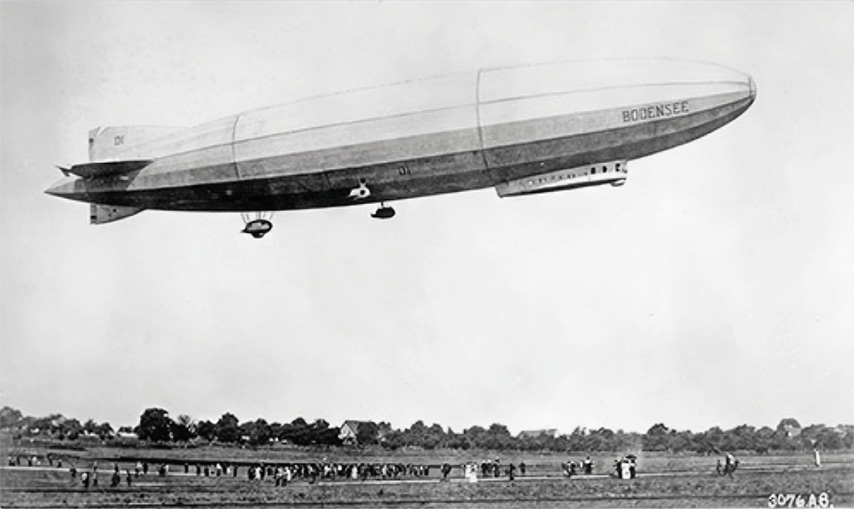
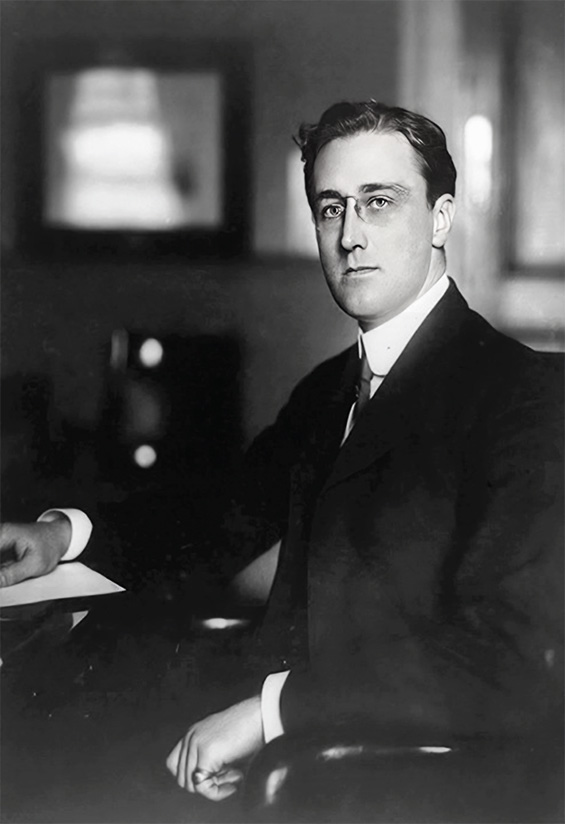
SPOTLIGHT: DR. HUGO ECKENER (August 10, 1868-August 14, 1954)
A German aviator among other academic and professional credentials, he was the premier airship expert of his time and considered to be the greatest airship commander in history. He served as the manager of the Luftschiffbau Zeppelin company and held several airship flight records. His safety record as commander was perfect until the infamous Hindenburg disaster. He was also a vigorous opponent of the Nazi regime and was blacklisted during that era as a result of his criticisms.

In July of 1919, the Naval Appropriation Bill for 1920 was passed in the United States, and it provided funds for the purchase of one foreign rigid airship, as well as a project to build a homegrown vessel. The import was the R-38, a British ship later renamed the ZR-2, with the ZR-1 designation given to the American model. The ZR-1 would later be christened the USS Shenandoah, and was based on captured designs from the German L-49 airship, which had been brought down intact by the Allies in 1917.
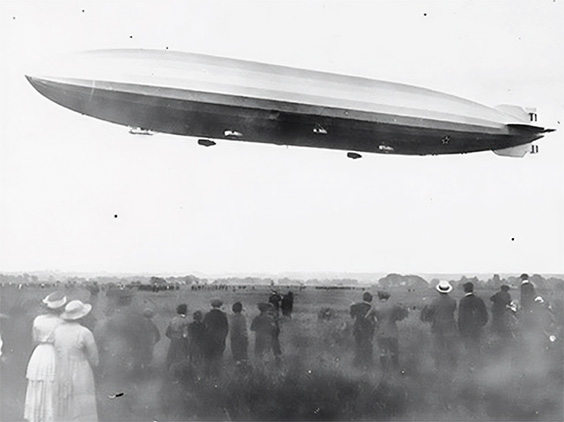
A US Airship Board was soon formed, and it charged the US Navy and US Army to work together in the development of the craft. The military branches were also instructed to collaborate with private commercial interests in the hopes of developing airship transport services for the general public. Then-Assistant Secretary of the Navy Franklin Roosevelt authorized the purchase of Camp Kendrick near Lakehurst, New Jersey as the site for a new airship base. In 1921, the Bureau of Aeronautics was established under the leadership of the Navy. The National Advisory Committee for Aeronautics, or NACA, which had been formed in 1915, supervised and coordinated research into aircraft development. By late 1921, the first-ever helium-filled airship flight took place, when the C-7 blimp lifted off from Naval Air Station Hampton Roads, demonstrating the viability of the gas. However, it was still very expensive and in limited supply.
While the US had not ratified the Treaty of Versailles, Germany still owed war reparations to the nation, approximately $800,000 worth. But instead of cash, diplomatic wrangling managed to secure the promise of construction of a new Zeppelin for American use.
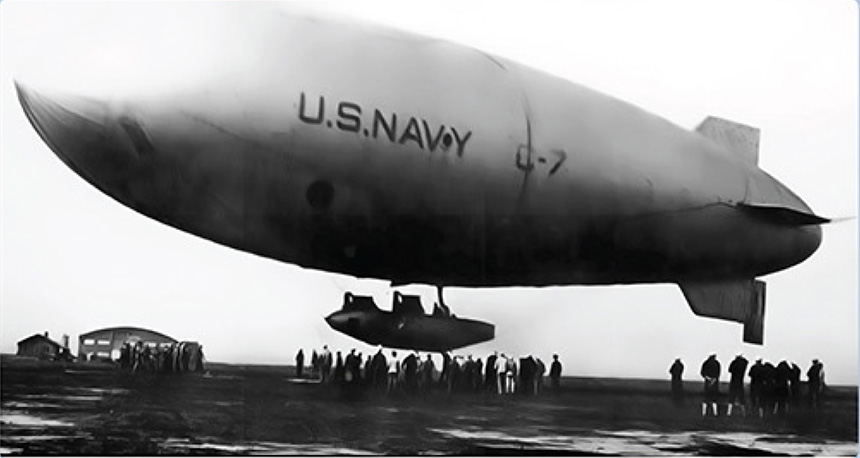
Airships Over America
As plans for what would become known as the ZR-3 were developed between the United States and Germany, a tragic accident led to the loss of the British-made ZR-2. A structural failure on its fourth trial flight resulted in a hydrogen fire that claimed the lives of 44 out of its 49 crew members, including the country’s best-trained air officers. The disaster was so dramatic that it threatened the nascent airship project in the US.
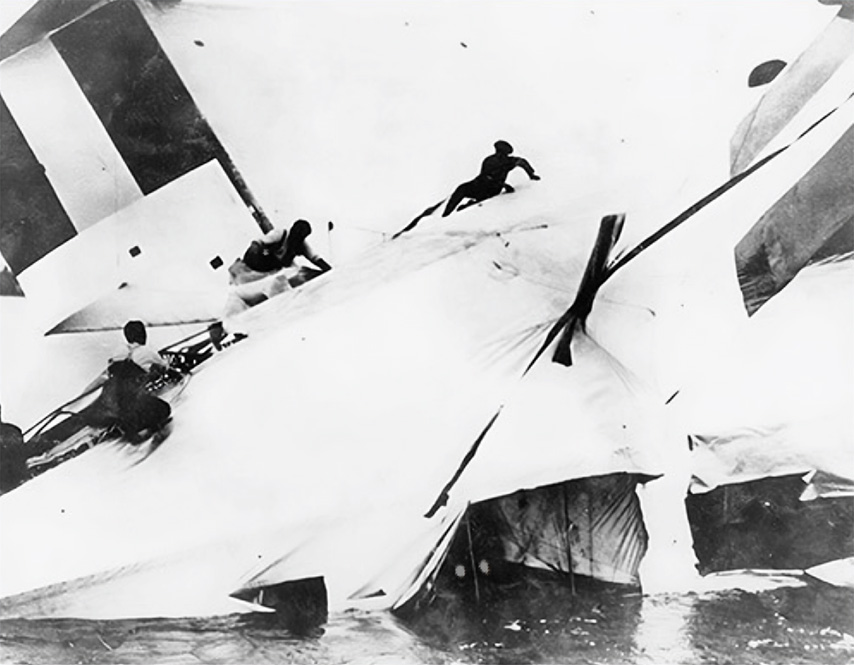
The only bright spot to this accident was that it allowed the US to exert pressure on the UK over its objections to the proposed larger size of the ZR-3, which would have exceeded London Protocol restrictions. The need for such a large ship (as proposed, 3.5 million cubic feet in capacity) had to do primarily with endurance: the larger the ship, the further it could go. Even just to reach the United States from Germany, the ZR-3 needed to be on the larger end of the airship spectrum.
The London Protocol’s strict size limits on airships were based on the fear of the military potential of such craft. The further the range and the higher the carrying capacity, the greater the military threat the ship presented. However, the ZR-3 was intended explicitly to be used for civilian and experimental purposes only, and not to be used in any military capacity. In the end, size restrictions were still imposed that scaled back the ship from its original planned specifications, but it was still the largest rigid airship yet to be built.

Interdepartmental squabbling between the US Army and Navy over control of the airship project characterized the early stages of the ZR-3’s development. Ultimately, the Navy took charge due to the obvious overseas advantages of airships. Work officially began in 1922 under the initial designation LZ-126, as this was the 126th design of the Zeppelin company. When complete, the ship would measure 658 feet long, with a diameter of 91 feet at its widest point, enclosing a lift volume of 2,599,110 cubic feet.
The internal structure of a rigid airship was a complex maze of aluminum and other lightweight metal girders, wires, and rings composing frames. Lifting gas cells were made out of strong, lightweight cloth with gas impermeable linings made from what were called “goldbeaters’ skins.” Named for their use in the refining of goldleaf, these were made from the outer surface of the large intestine of oxen, a byproduct of the meatpacking industry. These gas bags were vulnerable to puncture and degradation, however, so there was also much research and development over the following years to find better and less expensive materials to replace them.
While airships used gasoline to power their propulsion motors, but to a lesser extent than the competing airplanes. The outer skin of an airship was made out of fabric pulled extremely taut so that air resistance would be decreased as much as possible; slack skin would have negatively impacted the speed and fuel efficiency of the ships. There was a layer of air between the outer skin and the outside of the gas cells for additional protection from the elements.
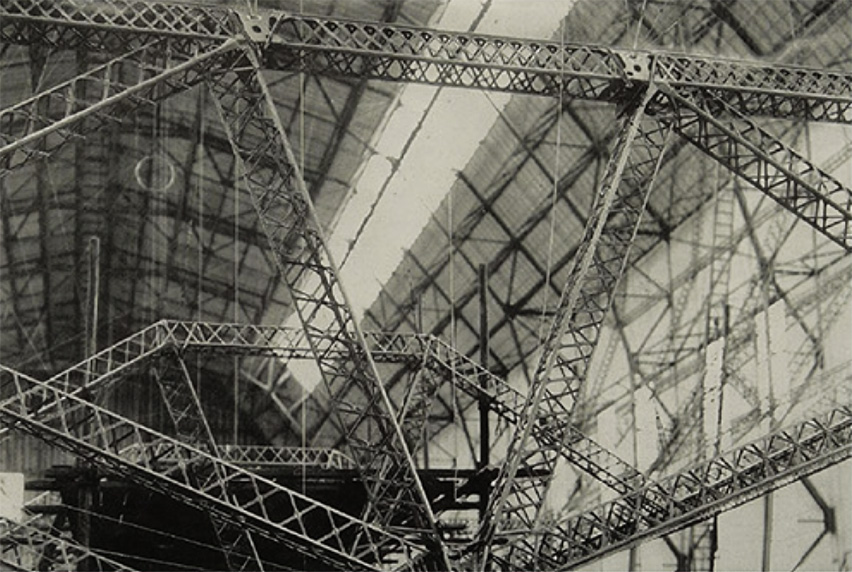
While the ZR-3 was under construction in Germany, the American-made ZR-1 was christened in October 1923 as the USS Shenandoah. The limited supply of helium meant that once the ZR-3 was completed and delivered, the two ships were unlikely to be able to fly at the same time.
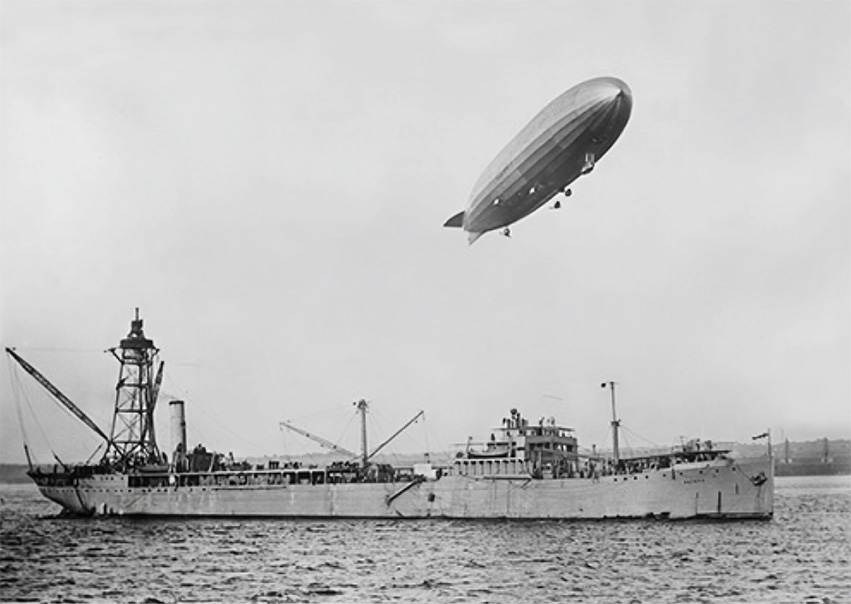
A number of test flights were undertaken by Dr. Eckener once the ZR-3 was completed in August 1924. It was extremely important that the ship be as safe and reliable as possible, as the fortunes of the Zeppelin company and the US Navy were intertwined; the project had thrown a much-needed lifeline to the company, keeping its doors open during the difficult postwar years in Germany. Even at this early stage, sources such as Aviation magazine speculated that the ship might find its way into the hands of commercial interests in the US, despite its being built for the Navy.
On October 12, 1924, the ZR-3 set off for the United States after finishing its test flight program. The launch was equal parts exciting and intimidating. The weather of the North Atlantic could be treacherous, and a rigid airship had not made such a flight before. According to Eckener, “It was clear that not only the lives of the participants, but also the fate of the zeppelin idea, would depend on our success. A failure would, in these circumstances, have meant the end of the Company in Friedrichshafen and with it the only place where the rigid airship tradition and the belief in its future were still alive.” However, for the very real peril that poor weather represented to rigid airships, there were also certain advantages. Under the right circumstances, they could fly around storm systems and use the winds to push them back on course rather than to try to fly against them.
By October 14, ZR-3 approached America, including Hammond’s neck of the woods. By 3:00 AM, the airship was in radio contact with RCA’s station at Chatham, Massachusetts. By the afternoon, the ship was on course towards Boston; by evening, the crew sighted Nova Scotia. At this stage, the dirigible was past its biggest hurdles. Boston Navy Yard sighted the craft at 3:00 AM on October 15, and Cape Ann was in sight by 4:00 AM. Soon after, the ZR-3 appeared above Boston: as Eckener put it, “The city was sound asleep, but it awakened for us. Sirens and steam whistles began howling while we were still far off; but they gave us some idea of what was in store for us.” At 4:20 AM, Eckener radioed the base at Lakehurst, New Jersey: “Will lay off operating till I get a look at beautiful Boston.”
Continuing its journey over Rhode Island, Connecticut, and New York, the ZR-3 successfully landed at Lakehurst, now the fourth aircraft to leap the North Atlantic. What’s more, it had made the longest nonstop voyage by any craft in history to that point. Eckener and his crew received a hero’s welcome. The trip had confirmed the viability of long-distance airship travel, much to the delight of F.W. “Willy” von Meister, a Hammond associate and the man in charge of Zeppelin’s affairs in the United States, who was the first to attempt to climb up the ladder to greet the crew. Acting as interpreter for Eckener, von Meister put it later, “When ZR-3 landed at Lakehurst… the enthusiasm for the first transatlantic voyage of a commercial airship–for delivery to the U.S. Navy–had a tremendous publicity result in the newspapers.”

The Los Angeles
As airship historian William F. Althoff writes, “Hitherto, commercial operations had been a German monopoly. No more. Editorials foresaw epochal results; great passenger craft were assured. Within months, indeed, the administration announced a policy fostering the development of commercial aviation, including lighter-than-air commercial service.” The United States was set to become a world player in air travel.
Despite the fanfare, however, there was a great deal to work out regarding the future of the ZR-3. It was decided that the US Navy would use the new vessel experimentally, to grow the service’s experience with dirigibles, and to assess whether or not the technology was truly useful. The leasing of the vessel to commercial interests was also discussed throughout 1925. It is here that John Hays Hammond Jr. enters the story, as he helped form a syndicate called the Airways Corporation of America with several other prominent businessmen with the explicit purpose of leasing a US airship for commercial travel.
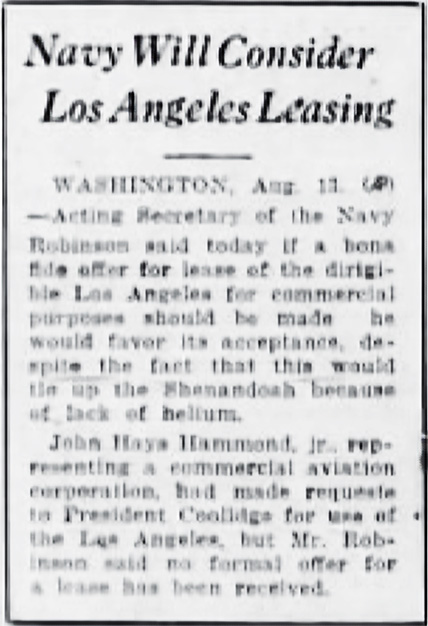
SPOTLIGHT: THE AIRWAYS CORPORATION OF AMERICA
A syndicate formed between John Hays Hammond Jr., consulting engineer Fred S. Hardesty, retired General Clarence Edwards, former Assistant Secretary of the Navy Herbert Satterlee, founder of RCA Owen D. Young, and likely other financiers. The company was incorporated in Boston sometime between 1922 and 1924, and its purpose was to build a US domestic and transatlantic commercial air travel network. Throughout 1925, the corporation sought to buy or lease either the USS Shenandoah or Los Angeles from the Navy. The proposal reached as far as President Calvin Coolidge, but fizzled out after the fatal crash of the Shenandoah in September of that year.
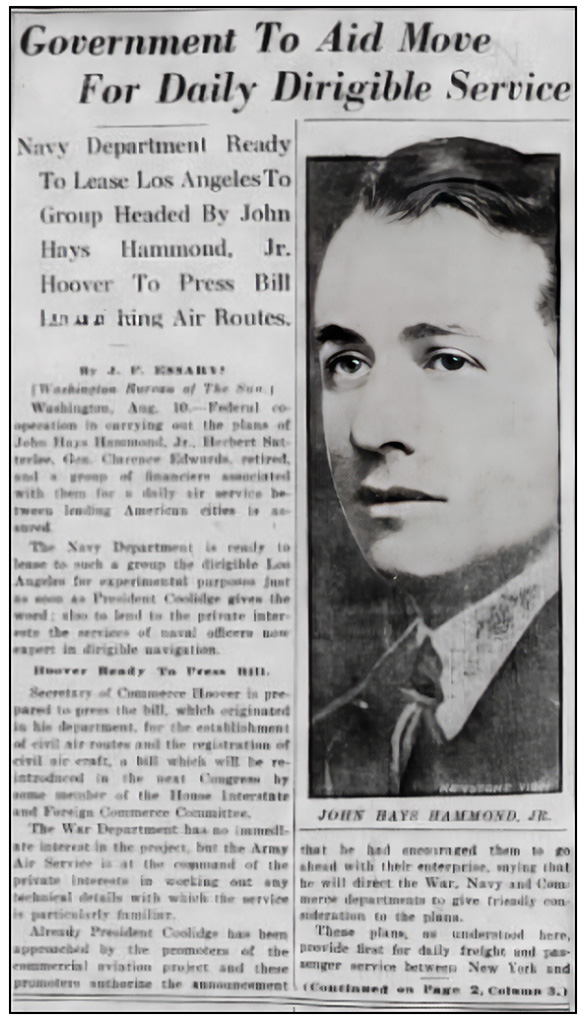
A major issue was that of the lifting agent to be used for US airships. The loss of the ZR-2 confirmed that hydrogen was too dangerous, and the Army-Navy airship board declared that all naval airships were to be filled with helium exclusively. Accordingly, the ZR-3, which had made its journey using hydrogen – still the standard in Germany – was deflated and refilled with helium. Due to the limited supply and expense of the gas, however, the ZR-1 and the ZR-3 could not be operated simultaneously. This led to a policy called “helium waiting,” where only one airship would be operated for months at a time, while the other was serviced.
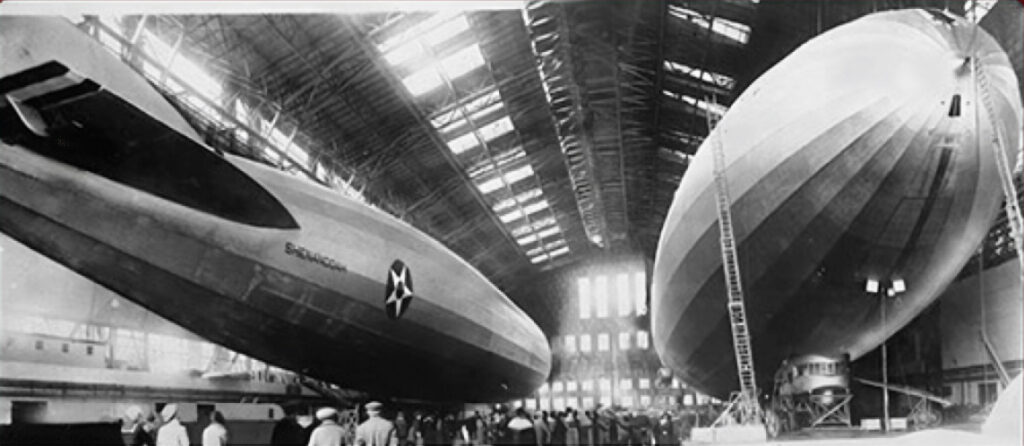
The successful arrival of the ZR-3 improved the relationship between the United States and the Zeppelin company, and, by extension, Germany itself. On November 15, 1924, the airship was officially rechristened the USS Los Angeles by President Calvin Coolidge and First Lady Coolidge, who became the so-called “sponsor mother” of the vessel.

The year 1925 would bring a slow start to the career of the Los Angeles for a variety of reasons. There was much experience to be gained in airship operation and maintenance, and lessons needed to be learned by the Navy regarding weather difficulties and challenges with mooring the ship. After the initial media blitz, this sluggish progress was noticed by the press, who wondered if the project would actually amount to anything substantial, or if it would be so much “hot air” in the end.
It must be recalled that this was an experimental craft operating in an experimental era. Early on, the Los Angeles was used for a variety of scientific purposes, facilitating, among other tasks, the observation of an eclipse.
As the year wore on, the airship did undertake a number of both attempted and successful flights in spite of its challenges. It was during this period that Hammond’s Airways Corporation petitioned President Coolidge for the sale or lease of either the Los Angeles or the Shenandoah for experimental use in the establishment of commercial air travel lines in the United States. Coolidge and others in his cabinet were initially receptive to Hammond’s overtures.
But as autumn 1925 approached, the story of the American airship took a tragic turn once again. On September 2, the USS Shenandoah crashed near Caldwell, Ohio. The ship had been torn apart due to a strong storm, resulting in the loss of not only the vessel itself, but 14 crew members.
The public reaction to this disaster was swift and severe, and many questioned the safety of dirigible travel. The press went so far as to call for the end of “murderous airships.” In the face of this, proponents of the technology, including Hammond himself, argued that this was a new science, that accidents, however tragic, were to be expected, and that this fact should not halt the development of the airship. President Coolidge seemed to agree, and desired a new ship to be built to replace the ill-fated Shenandoah.
As it was, however, the Los Angeles was then the only rigid airship left in service in the United States, and it navigated through a turbulent political and public atmosphere with its ultimate future uncertain. At the same time, the Navy continued to develop various types of dirigible balloons and blimps.
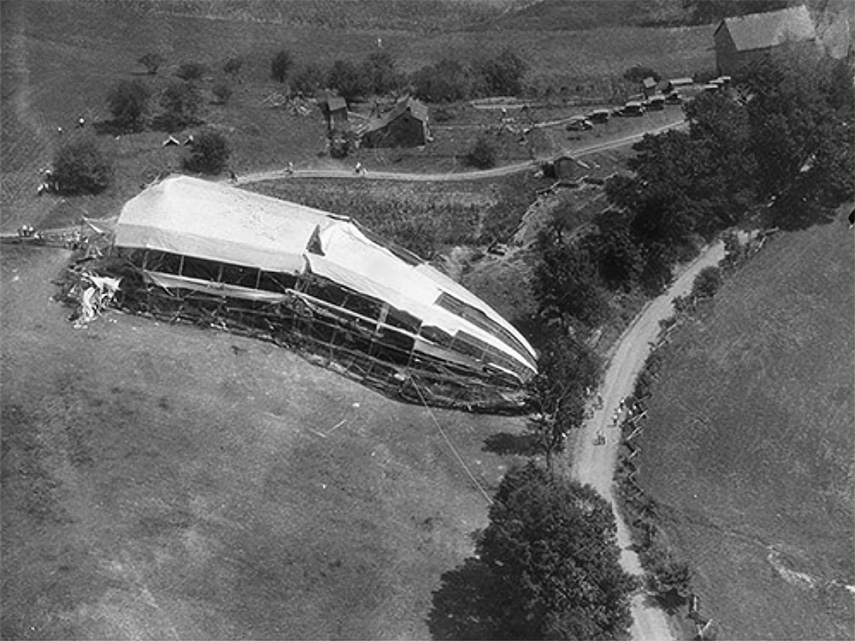
The Reign of Rosendahl
In May 1926, Charles E. Rosendahl succeeded the first captain of the Los Angeles, George W. Steele. Rosendahl was an intense figure who believed strongly in airship travel. His ascension helped to reinvigorate the fledgling program, but the ship still faced a slew of issues such as mooring difficulties and the deterioration of its gas cells.
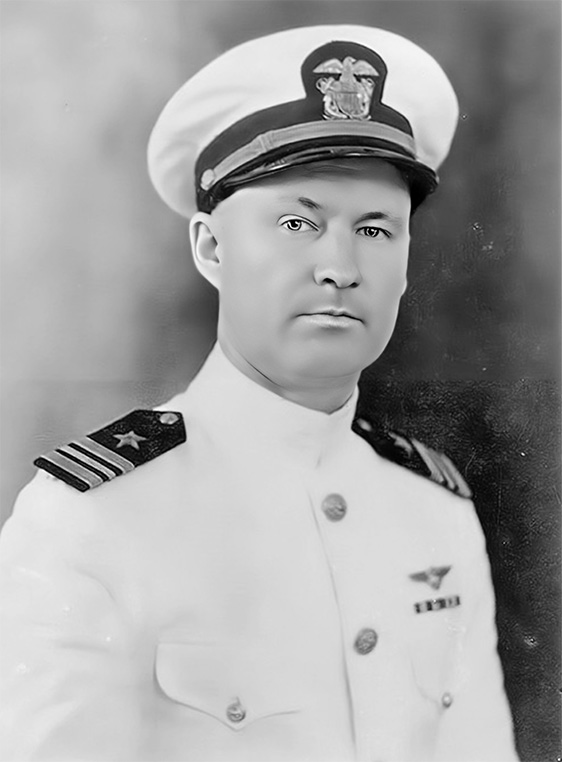
SPOTLIGHT: VICE ADMIRAL CHARLES E. ROSENDAHL (May 15, 1892-May 17, 1977)
A strong supporter of the U.S. Navy’s airship program. He served as the commanding officer of the dirigibles USS Los Angeles and USS Akron. During his distinguished naval career he also held command posts on various seafaring vessels prior to and during World War II. He was awarded the Navy Cross for his heroism during the Battle of Tassafaronga in 1942. In the early 1960s, he also attempted to organize an airship museum, but this was never realized. He was present for the final Navy blimp flight in 1962.
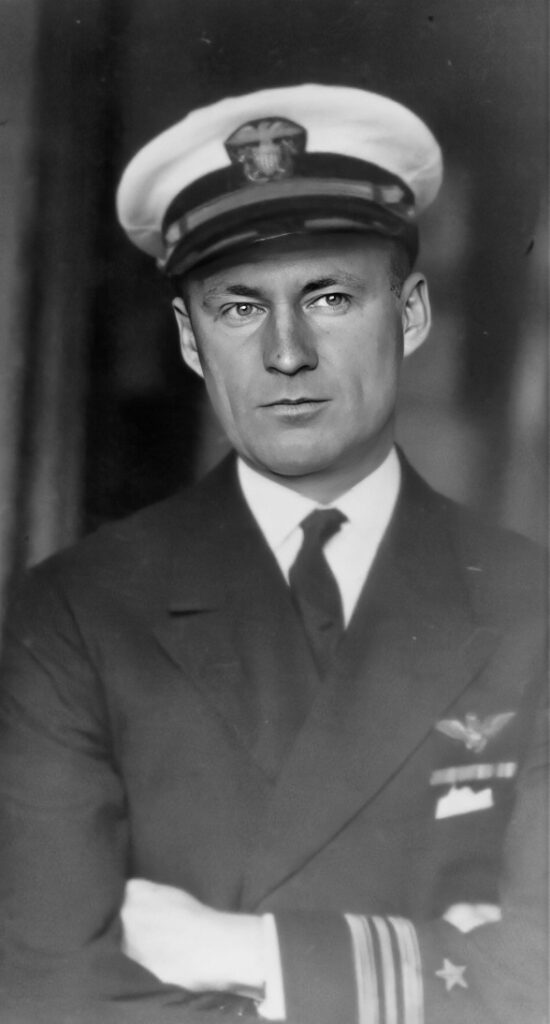
In one harrowing event, the Los Angeles found itself severely rocked by strong winds while moored to a tall mast. It was a startling sight, and one which was initially concealed from the press to avoid further damage to the reputation of the airship. Ultimately, however, the damage to the vessel itself was minimal, and the incident led to the development of the short, or “stub” mast, which protected the ship from such dramatic updrafts while moored.
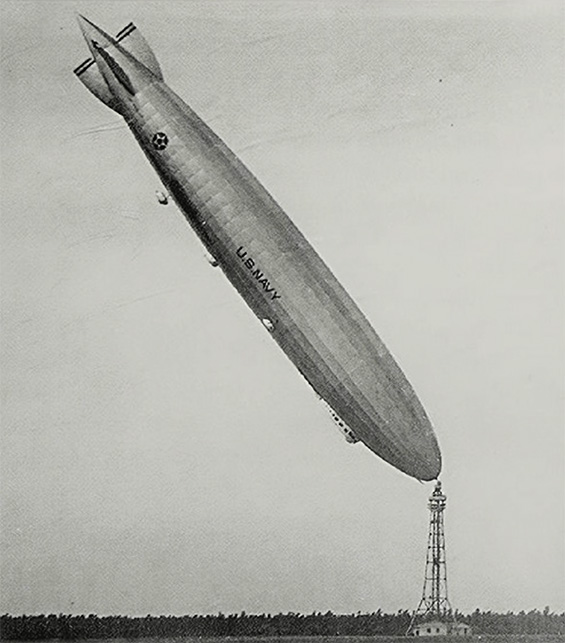
As Lieutenant Francis W. Reichelderfer, a meteorologist and aerologist who served aboard the Los Angeles, recalled, this was a time of creativity and innovation: “One of the very intriguing things about airship duty was the creative aspect of that whole operation. It was an experimental and research organization almost as much, perhaps more, than it was an operating organization. So we were all busy trying to think of new ways to improve airships and new ways to define and measure and quantify the elements that came up in airship operation…”
But nevertheless, there was stiff competition from advocates of heavier-than-air craft: namely, airplanes. With only a single airship in operation in contrast to the thousands of planes under the command of the US Navy, the dirigible was definitely the underdog. As Reichelderfer stated, “This was really a matter of survival. The constant pressure for funds, the competition between heavier-than-air and lighter-than-air showed itself in the fact that the [HTA] proponents would emphasize the [airship’s] limitations, while we in the airship field would seek always to find some new use, particularly a use that an airplane couldn’t do.” One of these airplane proponents was Senator Hiram Bingham III of Connecticut. The so-called “Flying Senator,” himself a pilot, dismissed the airship as a means of overland travel due to its slow speed, and considered it only useful over the ocean. His influence was such that President Coolidge appointed him to the President’s Aircraft Board.
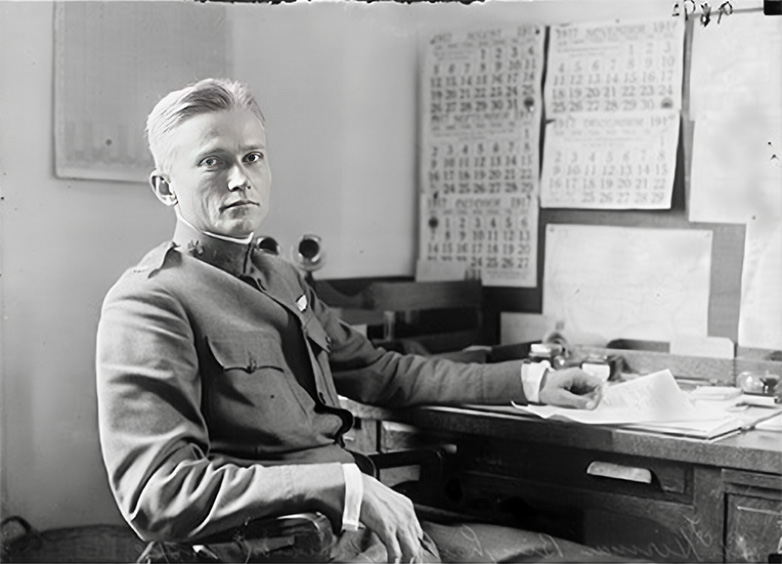
A notable opportunity for the Los Angeles to prove its worth came in January 1928, when it took part in an experiment to determine if it were viable for an airship to land upon a Navy carrier as a means of obtaining emergency refueling. If successful, it might make a strong case for the airship to accompany the fleet in its missions across long distances, extending its usefulness. The Los Angeles successfully landed upon the USS Saratoga, but only for seven minutes due to the weather and sea conditions at the time. Rosendahl nevertheless viewed the mission as a success: “In spite of the fact that this was the first attempt with a large airship,” he wrote, “and although hasty arrangements and only crude equipment were available on this initial attempt, this operation is considered to have proved the feasibility of landing an airship on the deck of a large ship.” However, the experiment ended up as just a one-off; late in the Second World War, some blimps would use aircraft carriers as refueling stations, but not rigid ships.
About a month following the Saratoga experiment, the Los Angeles embarked upon a trip from New York to Panama, then to sea near Cuba. The voyage was mostly successful, apart from rough conditions on the final stop due to poor weather. However, Rosendahl concluded that the airship was too small to be viable for regular transatlantic trips, despite the initial journey it had taken to reach the United States. Accordingly, he advocated the need to develop larger airships.
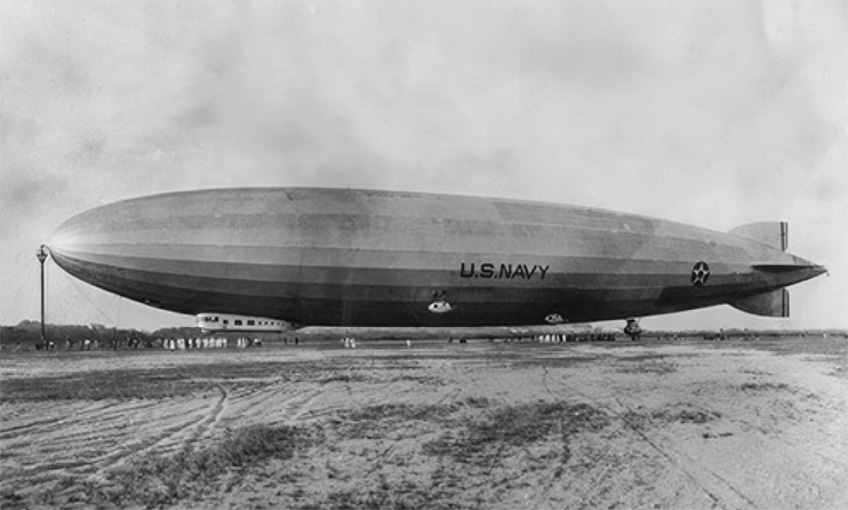
The Great Depression
By 1929, there was a new airship in the skies: the celebrated Graf Zeppelin. This ship was a symbol of the progress in the art that Rosendahl dreamed of; larger than the Los Angeles, it cut transatlantic crossing times in half. During a trip to Lakehurst, Dr. Eckener and von Meister met with interested businessmen, including Walter Chrysler, founder of the famous automobile company, hoping to interest them in investing in the zeppelin enterprise.

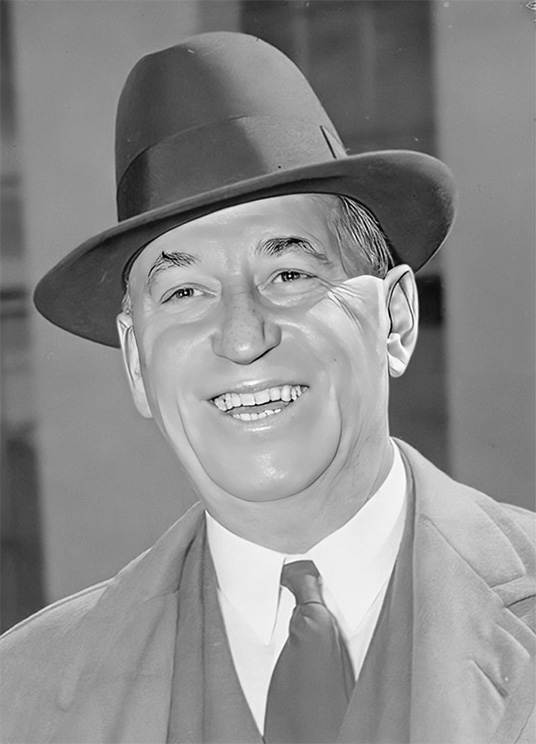
There was renewed enthusiasm for the airship within the Navy as well. Edward P. Warner, the assistant secretary of the Navy in charge of aeronautics, stated, “There have been thirty attempts to cross the Atlantic by airplane in ten years, and nearly two-thirds have failed. Every airship, on the other hand, that has tried the same thing has met with success. On the side of practicability there is no comparison.”


In August, the Graf Zeppelin undertook a successful circumnavigation of the globe to much fanfare and acclaim. Its achievement helped to revive the airship’s prospects in the public imagination. Meanwhile, the Los Angeles continued its experimental work, including participating in various radio transmission and reception experiments with RCA Victor.
Of course, 1929 also marked the beginning of the Great Depression. While the airship program continued despite the uncertain economic climate, it would eventually have to reckon with the financial reality. Despite Warner’s bullish assessment of the airship over the airplane, the latter was clearly ahead of the former. The unit cost of heavier-than-air craft was far lower than lighter-than-air craft. This made the airplane a much more attractive option for investors, while airships remained within the province of state-sponsored investments. More importantly, airplane technology was advancing much more rapidly than that of dirigibles, and this fact threatened to erode the airship’s advantages.
With the benefit of hindsight, it is easy to argue that the eventual dominance of the airplane was an obvious conclusion. However, as Althoff reminds us, “the airmen of 1919-39 were not clairvoyants; nor were the denizens of the engineering world. Ever attentive to the problems of flight, ‘with a view to their practical solution,’ NACA was stimulated in 1929 to declare: ‘If the United States is to take full advantage of the possibilities of air transportation, especially in the field of transoceanic air travel, the importance of rigid airships can not be overemphasized, as in transportation by air over long distances, and especially over water, rigid airships have marked advantages over airplanes.’”
It must be remembered that in the early 1920s, airplanes were relatively tiny and slow. Airships, while slower still, were nonetheless not massively so, and had a much higher carrying capacity. They were also considerably more comfortable for passengers; most planes of the time had open cockpits and sat only one or two people, one of which was the pilot. From an economic perspective, while the upfront per-unit cost of an airship versus a plane was high, its operating costs were comparatively low, and its range far greater. This opened avenues for considerable revenue generation over the airship’s operational lifespan.
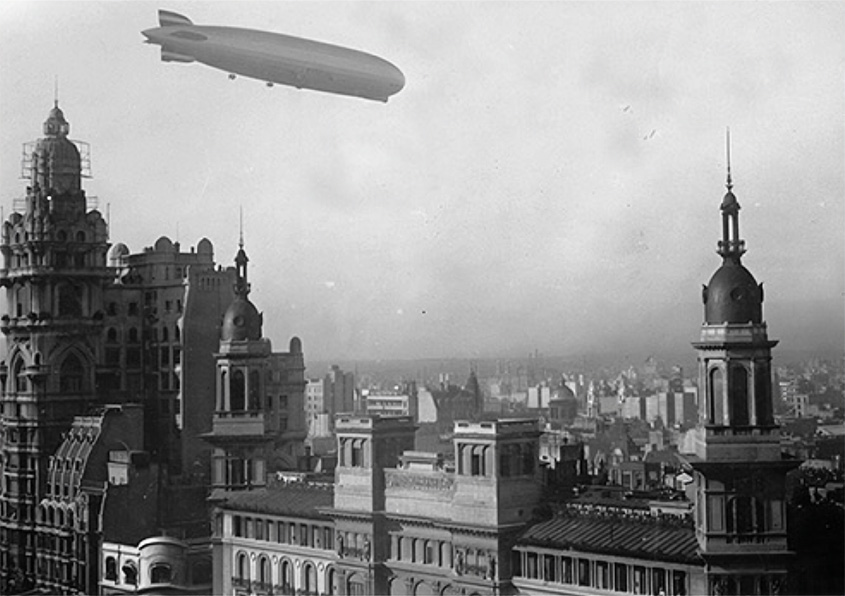
Grounded
By the start of the 1930s, the future of the airship in America remained in doubt. The economic effects of the Great Depression began to be felt more keenly, and the Los Angeles was showing her age. She was five years old, and had logged almost 2500 hours and 100,000 air miles. Her gas cells were worn. In fairness, she was an experimental vessel, and consequently it was difficult to judge her expected lifespan. A board was therefore convened in March 1930 to assess her overall fitness.
Fortunately, the airship was found to be in remarkably good condition, especially considering her unique circumstances. It was still difficult to predict when she would reach the end of her useful service life, but she was estimated to have at least two-to-four years left in her. So the Los Angeles continued on, as the younger and larger Graf Zeppelin rose in prominence.
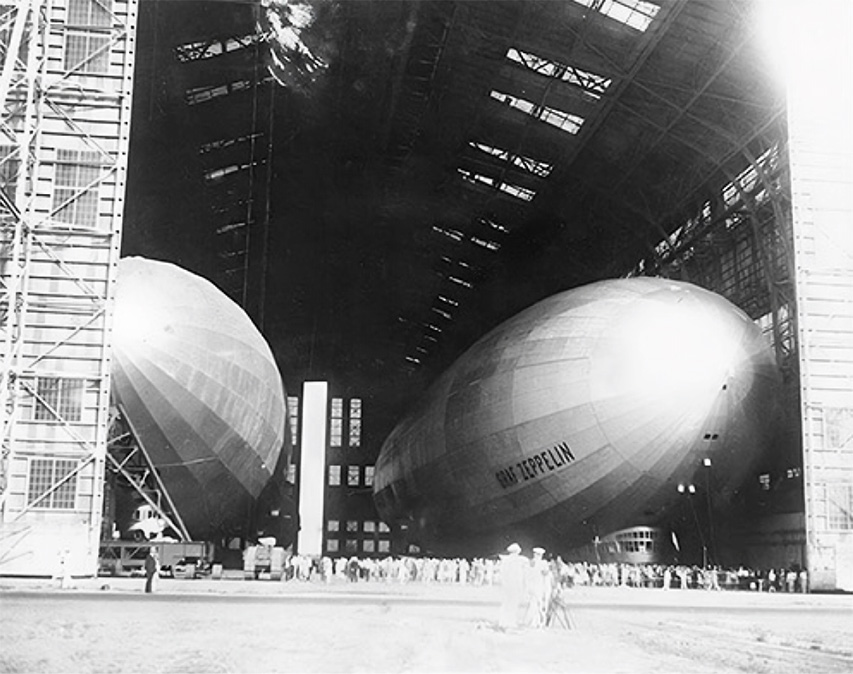
In August 1929, the National Air Races featured the Los Angeles, as the ship made the first public performance of hooking onto an airplane. The airship’s potential as an aerial carrier for airplanes was seen as valuable, using the dirigible’s greater range to its advantage.
In a hopeful sign, two new airships would be constructed by the Navy: the USS Akron and the USS Macon, named after cities in Ohio and Georgia, respectively. These would be larger than the Los Angeles and of similar design to one another. However, in light of this development, in 1932 and into 1933, the future prospects for the Los Angeles itself dimmed. In the 1933 Naval Appropriations Bill, the Naval Subcommittee advised that the Los Angeles cease operations by July 1, 1932, and that if it were not sold, it should be scrapped.
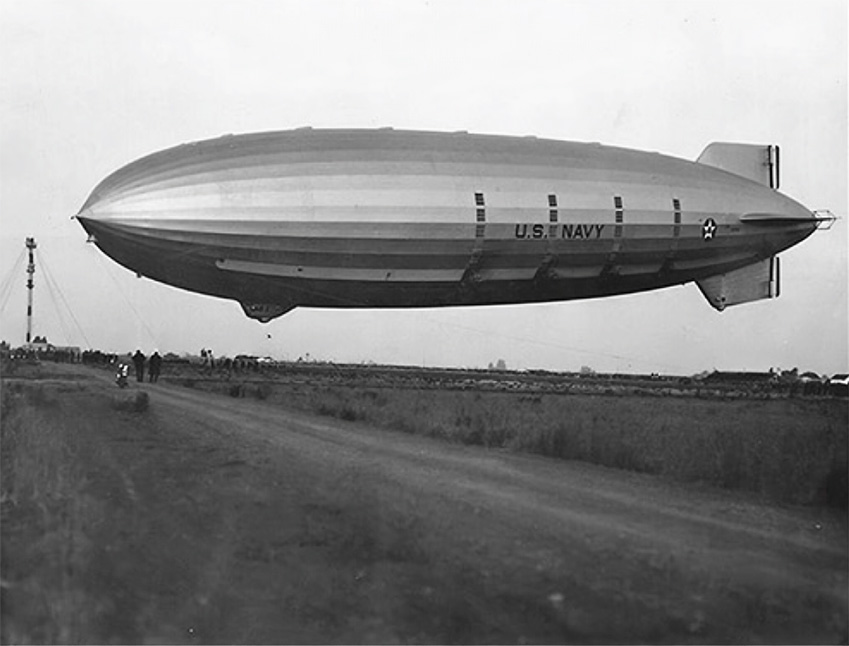
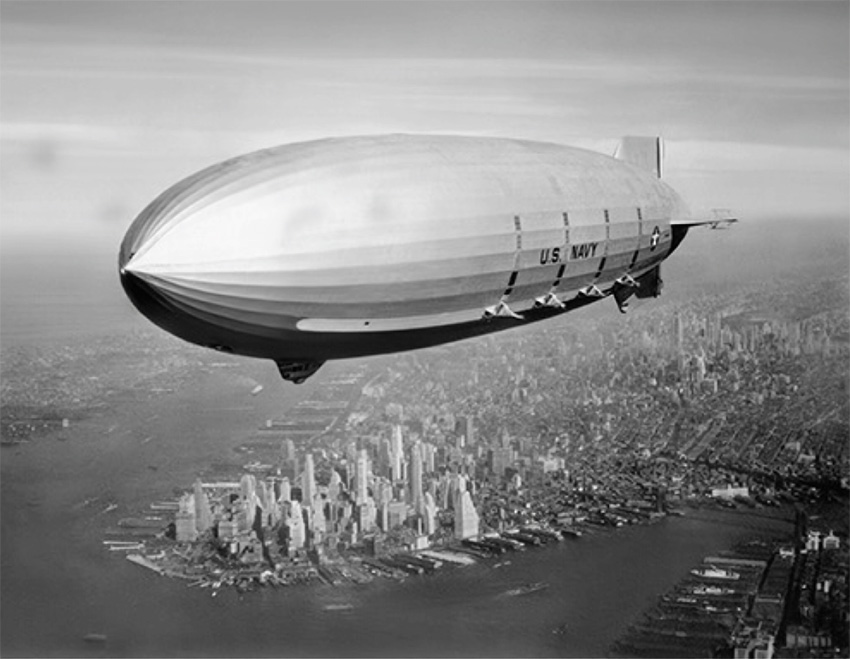
This decision was essentially financial: $270,000 had been requested for the year to maintain the operation of the Los Angeles, which was deemed too costly. It is worth noting here that, ironically, this same appropriations bill provided John Hays Hammond Jr. the sum of $750,000 in back payment for the use of his patents by the US Navy. By 1933, however, Hammond and the Airways Corporation of America seemed to be out of the airship business, and would not come to the aid of the Los Angeles as they might have done eight years earlier during the Coolidge administration.
Ultimately, the decision was made to ground the Los Angeles. Despite being flyable, it was placed on inactive status, albeit with the possibility left open that it might be recommissioned at some future time or sold to a private enterprise. This decommissioning had a number of negative impacts on then-in-progress experimental projects, and threatened to stifle the advancement of airship technology itself within the United States. A focus on the Akron and the nearly-completed Macon was deemed to be of greater potential value than maintaining the aging Los Angeles, despite its relatively good condition and successful record.
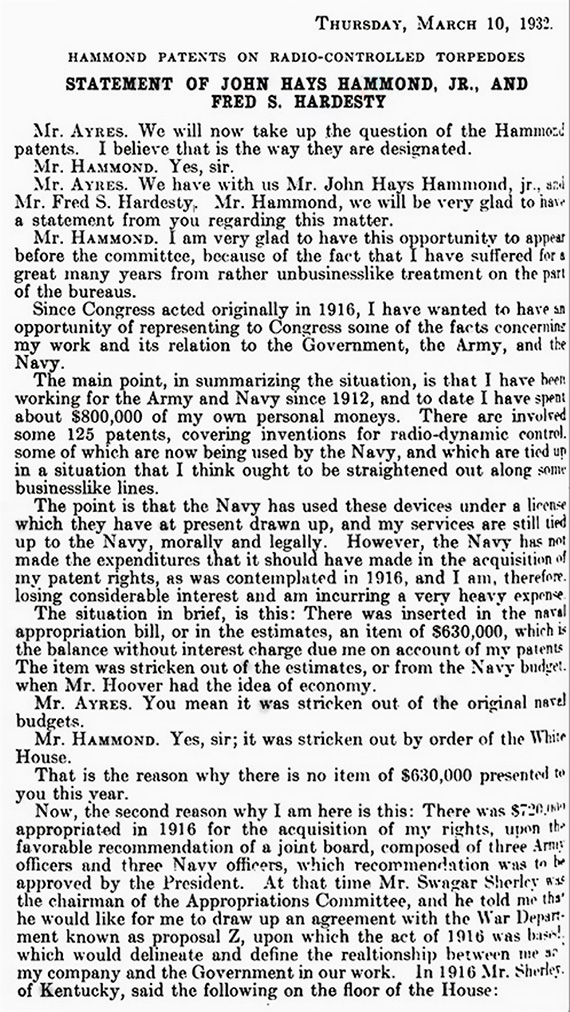
A Laboratory Ship
The airship was a subject of much skepticism in the early 1930s, despite continued development. As a result, airship advocates found it necessary to adopt an evangelical approach in pursuit of advancing their agenda. As Lt. Reichelderfer put it, “This was part of the mission of practically everyone in airships, because it was a small service. It was a service that people had many questions and doubts about, so that you were automatically–if you believed in airships–cast in the role of being a salesman whenever you talked with people who were interested in knowing more about them.”
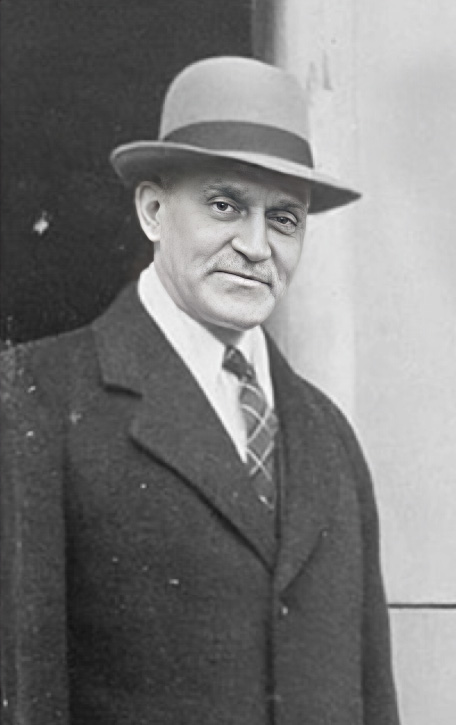
Following its grounding in 1932, the Los Angeles endured until nearly the end of the decade, but it would never actually fly again. Its main problems were maintenance costs and obsolescence in comparison with newer ships. Otherwise, the machine was perfectly serviceable. The airship spent the first 18 months of its grounding dormant, thought it was maintained during that period.
Having since ascended to the presidency, Franklin Roosevelt had cooled significantly from his evident earlier interest in airships. Admiral William A. Moffett, one of the Navy’s biggest airship defenders, continued to advocate for the technology: “We need more dirigibles. I hope the President will include at least two more of them in his public works construction program. But the deep-sea admirals in the navy don’t believe in them. They’re suspicious. They have an idea they’re not safe.”
Unfortunately for Moffett, these words would soon live in infamy. Late on April 3, 1933, the USS Akron took off on a routine flight that would end tragically the following day. Unknowingly, the ship flew headlong into a violent storm front and was lost at sea. There were only three survivors out of the 76 onboard. Sadly, Admiral Moffett himself was among the casualties of the accident.

SPOTLIGHT: REAR ADMIRAL WILLIAM A. MOFFETT (October 31, 1869-April 4, 1933)
The leader of the Navy’s Bureau of Aeronautics and a strong supporter of the development of naval aircraft. A staunch believer in the airship, he paid for his faith with his life while aboard the USS Akron during its disastrous final flight. The ship was caught up in a storm over the Atlantic Ocean off the coast of New Jersey and sank, claiming the lives of most of the crew. The Grace F, a Gloucester, Massachusetts-based fishing boat, assisted in the search for remains.
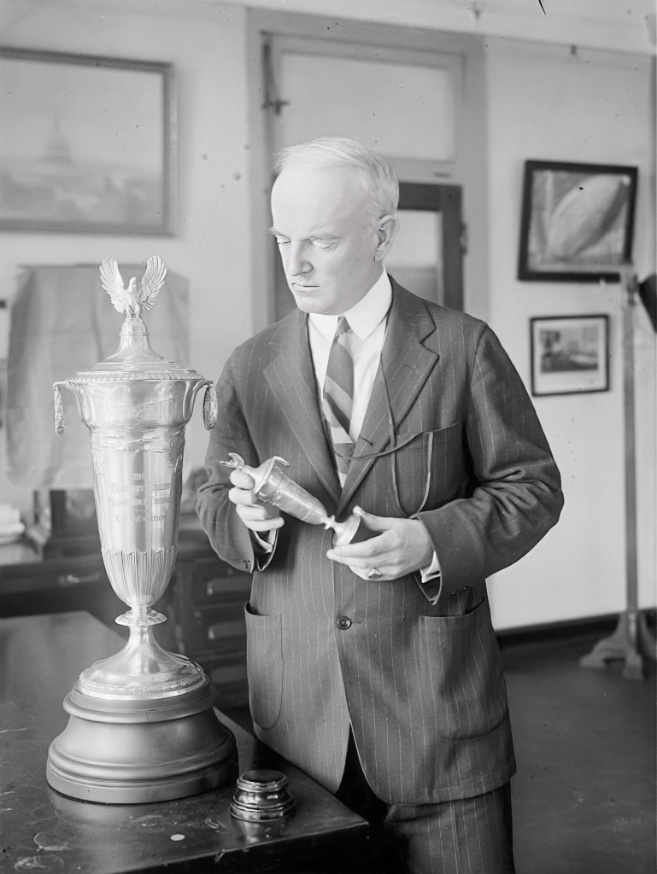
One possible explanation for the crash was that the tail of the vessel might have accidentally made contact with the water due to the then-primitive altitude measuring systems in use. The bridge crew might have believed that the ship was higher than it really was. Later developments in radio altimeters would have prevented such a mistake, as they used radio waves that bounced off of the surface of the water and back to the craft to more accurately measure the actual altitude.
President Roosevelt called the crash “a national disaster.” Secretary of the Navy Claude A. Swanson deemed it “one of the greatest peace-time blows the Navy has ever experienced.” Captain Rosendahl was shocked: “Through my personal experience I know the Akron previously survived the severest tests of any airship in history. The Akron’s loss baffles me.” The media coverage was unfavorable, reiterating its old charge that airships were too dangerous. The New York Evening Journal, in an opinion piece, commented, “Informed opinion differs widely as to [airships’] usefulness… All that the layman can conclude is that they have not yet reached a stage of development which fulfills the expectations of their sponsors.” Representative Carl Vinson, chairman of the House Committee on Naval Affairs asserted, “There won’t be any more big airships built. We have built three–and lost two.”
A joint investigation by a special committee charged with investigating airship disasters was soon formed. During the course of their inquiries, the committee heard testimony from none other than Fred S. Hardesty of the Airways Corporation of America, Hammond’s longtime associate, during which he was questioned as to whether the corporation had lobbied the Navy to construct the Akron and Macon, as advised by their financiers. He stated that while the moneyed interests behind the enterprise did suggest that he and others in the company petition the Navy for new airships following the loss of the Shenandoah, that ultimately it was agents of Goodyear-Zeppelin who were the driving force behind the two airship projects.
In the end, despite the outcry both in the press and by members of the government, the committee came to a remarkably levelheaded conclusion: it indicated that airship technology was still worth pursuing, as the vessels had demonstrated that they were of great supplemental value to naval missions.
Despite this report, Secretary Swanson was unconvinced. Writing to FDR, he stated, “I can find no justification for recommending the construction of additional lighter-than-air ships so long as the MACON is available for carrying on the experimental work, or until such operations of this ship clearly indicate that further construction is desirable.” As Althoff writes, “For the rigid type in the United States, it was the beginning of the end.”

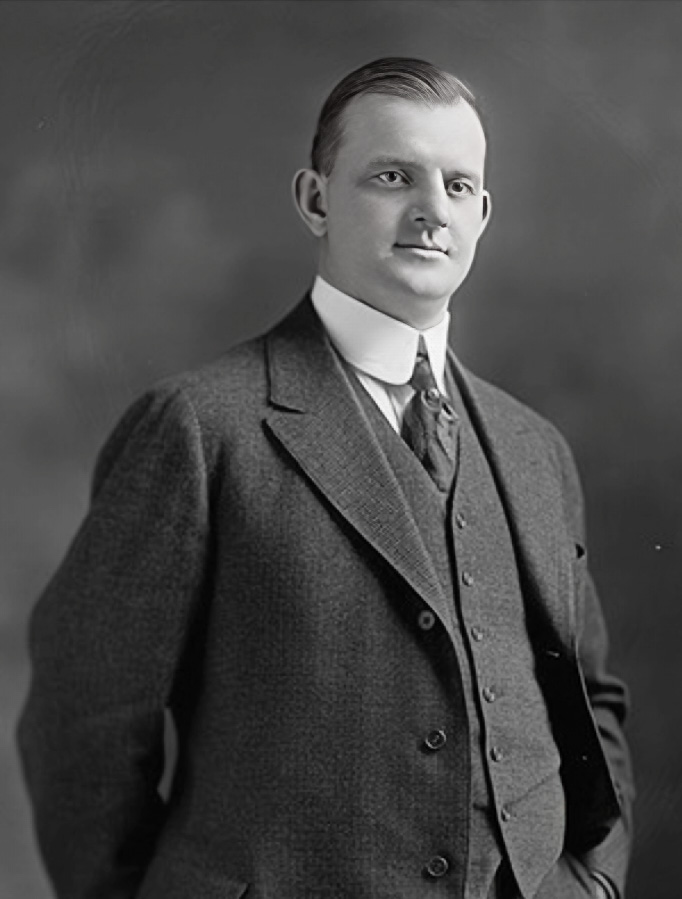
The Twilight of Airships
In the wake of the Akron disaster, the future for airships in America appeared bleak. The Los Angeles remained grounded, relegated to use as a laboratory ship. Despite pleas to resurrect her as a training vessel, the expense was too great for the expected return on investment. Furthermore, the base at Lakehurst was in decline and reduced to a skeleton crew. Airship advocates decried the sidelining of the Los Angeles, and maintained that all inspections showed that she continued to be in remarkably good shape, all things considered, and therefore worthy of investment. In October 1933, Secretary Swanson placed the Los Angeles on a list to be scrapped, but her defenders managed to persuade the Navy to preserve her for experimental work and earned what became a six-year stay of execution.
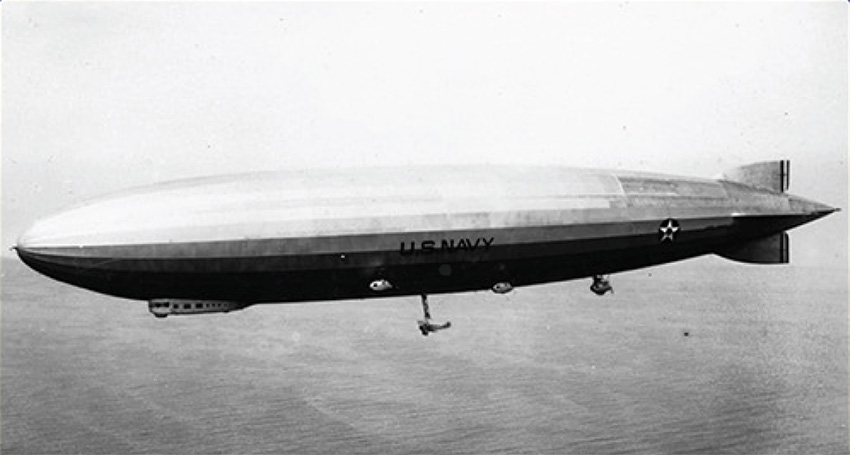
Meanwhile, the USS Macron had launched in April 1933, and saw some use as an aerial aircraft carrier, but it was ultimately tapped for tests as a scouting vessel the following year. However, in February 1935, the Macon suffered an accident and sank at sea like its sister ship the Akron. The only silver lining to this disaster was that it took less of a human toll, as all but two of her crew survived.
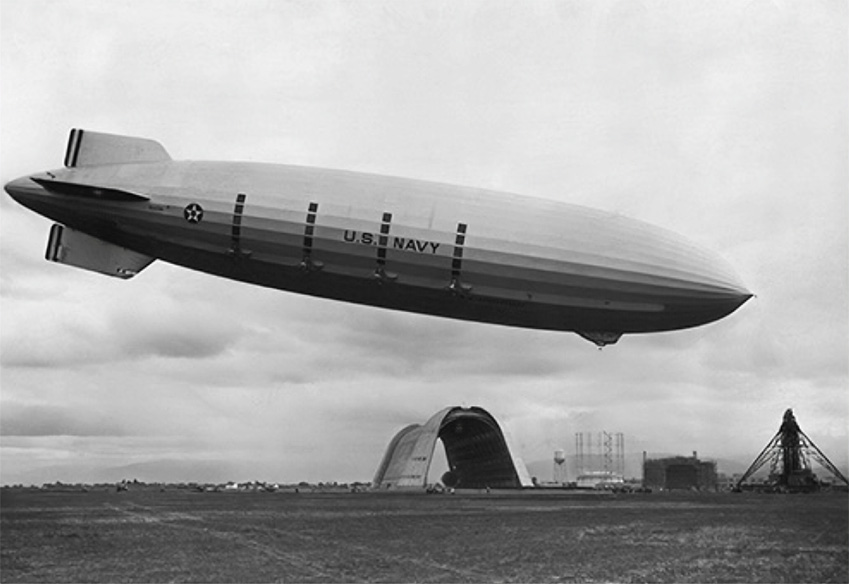
Althoff neatly summarizes the situation as of 1935: “It is commonly assumed that rigid airship development in the United States ceased with Macon. Much of the remaining hope for a future for large airships, indeed, had foundered with her. Macon was the last of her kind commissioned in the United States and the last to be built there. Nor did a ZR ever again take to the air to explore further the uses of airplane-carrying airships for strategic scouting. The political climate had soured, certainly. Within days of the foundering President Roosevelt said he would not recommend further expenditure for such projects… ‘Frankly,’ Swanson remarked, ‘I do not know whether lighter-than-air craft justify expenses and accidents. We need other things worse, ships and air-planes for instance.’ The collective weight of such opinion would prevail.”
To his credit, Swanson did authorize the formation of the Durand Committee to assess the viability of continued airship development. The committee found in a report that safe rigid airships could still be built, but argued that the Navy had rushed its ships to service too quickly, without enough time for a proper battery of tests. It concluded that the Navy should have approached the development of airships as models first, for study and training, and that if they pursued such a course, it might eventually lead to ships that might see regular service. Instead, the Navy had subjected the experimental craft to dangerous conditions that led to the disasters that characterized airship projects within the United States.
The Navy remained ambivalent at best to the viability of airships as a technology, and hostile at worst. The general view questioned the project from a cost-benefit perspective: the Navy was uncertain that the potential gains of continued airship development could justify the costs in men and materiel. Nonetheless, there were proposals that a new training ship should be built, perhaps even from a refit of the Los Angeles, but this was ultimately determined to be impractical.
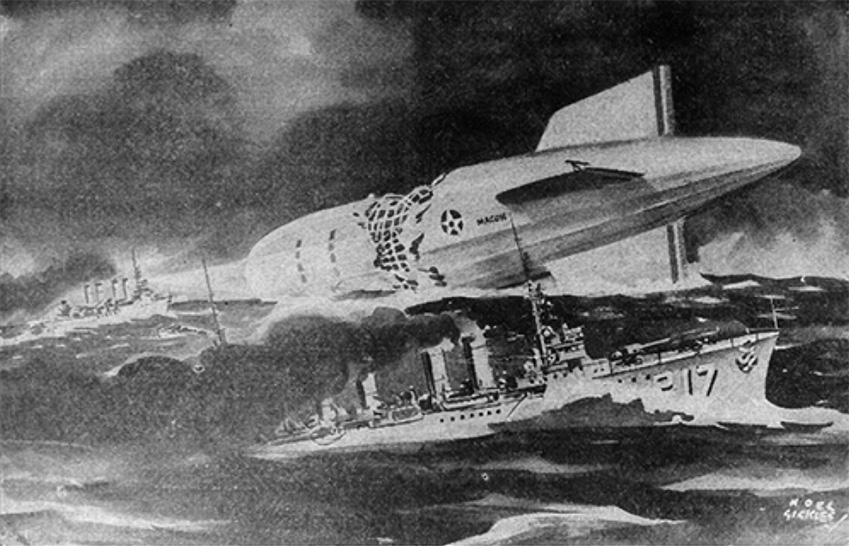
The Hindenburg Disaster
By the mid-1930s, Germany, having continued dirigible development, unveiled the famous Hindenburg, the largest rigid airship yet built. With the support of Dr. Hugo Eckener, the ship began a series of demonstration flights to the United States. For their part, the Navy recognized the value of sending naval personnel on some of these voyages for training purposes.
To support these flights, Eckener personally wrote to President Roosevelt to lease terminals in the US, suggesting that this might help stimulate American efforts to offer commercial airship flights, such as Hammond and the Airways Corporation had attempted a decade before. However, these flights coincided with the rise of Nazi Germany, and while they were not yet engaged in war, there was a growing American hostility towards the fascist regime that soured US-German relations and meant that Zeppelin would have to foot the bill for the flights.
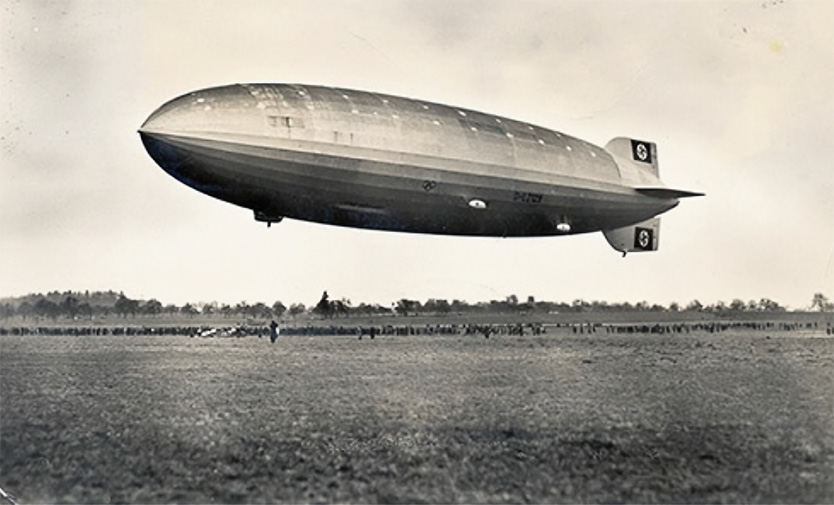
The Hindenburg received very positive reviews from those who flew on it and appeared to demonstrate that the airship had matured as a technology. Flights were not only more comfortable than those on American airships, but far more luxurious accommodations were provided. It seemed to be a smooth-operating ship that had the potential to revive the popularity and commercial potential of airship travel both within the US and abroad.
Back in Lakehurst, Eckener himself inspected the Los Angeles during one of his trips, and was very impressed with how well she had been kept up. Other experts weighed in with similar assessments, and believed she was safe for recommissioning. Indeed, with the success of the Hindenburg, some airship advocates used the opportunity to argue that the US needed to revive the Los Angeles and build more of its own ships to compete with Germany. Despite these arguments, there was little political will to finance continued airship operations.
By 1936, however, the prospects of commercial US airships momentarily brightened. In a report, the Business Advisory Council recommended that an airship policy and program be developed, and this received some attention. If there were not much of a future in the Navy’s airship program, perhaps private enterprise could finally step in to take the technology and run with it. While hearings were held before the House Naval Affairs Committee in August 1936 concerning a new airship project, little came of it.
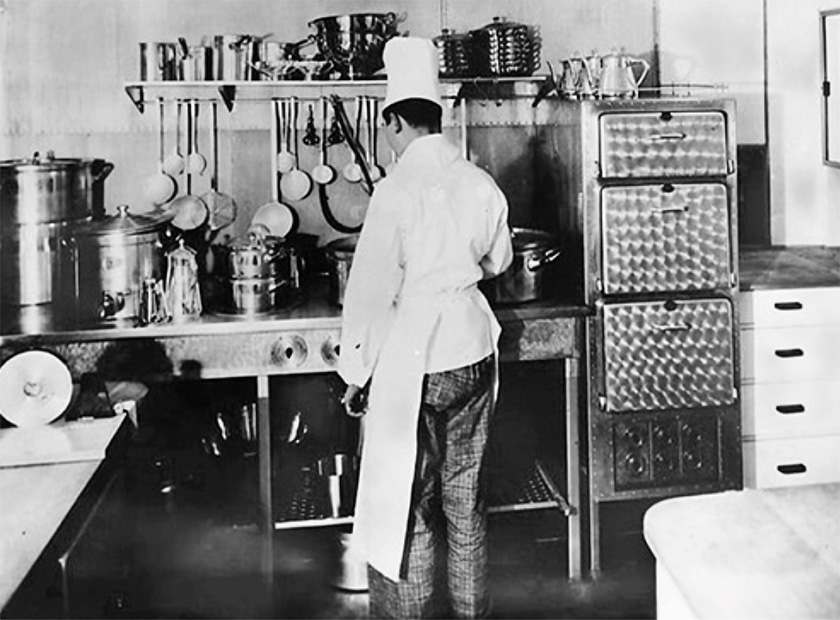
While the fledgling US airship program, exemplified by the plucky Los Angeles, continued to fight for survival and growth, the German equivalent was on the upswing. Between the Graf Zeppelin and the Hindenburg, transoceanic airship travel seemed like a reality that was here to stay. There was even some discussion that a US company might charter its own airship from Germany. But for all the ebullience, the winds were soon to change.
On May 6, 1937, the Hindenburg was scheduled to arrive at Lakehurst from overseas. It was to take on new passengers and crew, including US naval officers, and then return to Europe. While poor weather delayed its arrival, multitudes were present to greet the ship when it eventually arrived, including Willy von Meister. But he noticed that something wasn’t quite right when the airship came into view, observing that its tail dipped repeatedly as it approached its mooring mast. Beyond this seemingly-small irregularity, however, everything appeared to be business as usual.
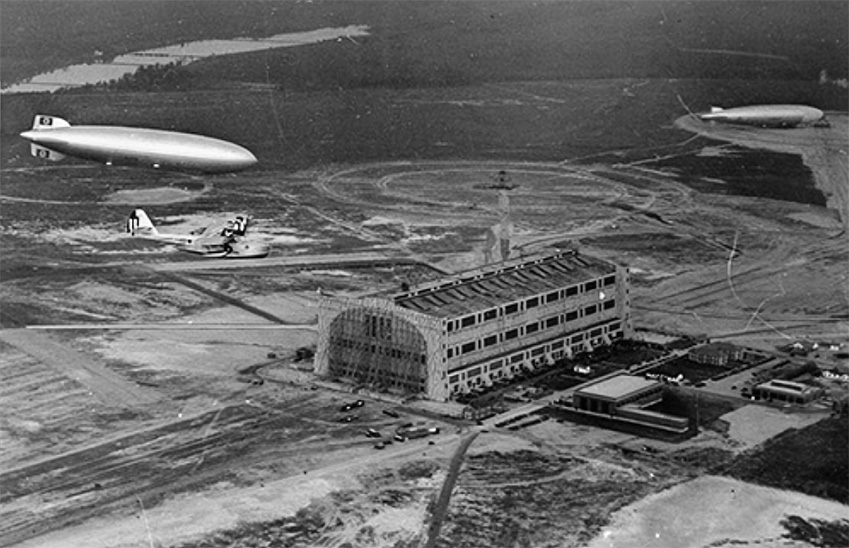
That calm image soon evaporated: to quote Althoff, “Von Meister saw a flame burst out atop the hull, just ahead of the fin. Through the cover he noted a shine, a glow that progressed downward, deeper in. Abruptly, the entire stern was afire… many thought there was an explosion. The concussion threw some to the ground… Reichelderfer… was in his quarters packing for ‘the most perfect kind of travel that I know.’ Then came a dull thud. Looking at his wife, ‘Uh oh,’ he murmured.”
The explosion and fire was rapid and devastating. A historic disaster was in the making. More than a third of those aboard perished as a result, 35 out of 97, as well as one of the ground crewmen. While a number of theories have been put forward over the years, it is still not definitively known how the fire started – what is known is that hydrogen was the fuel.
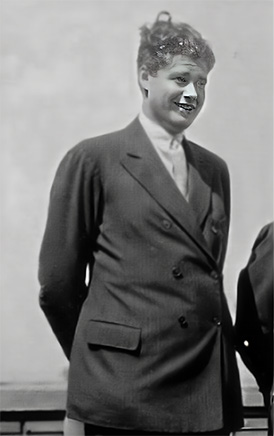
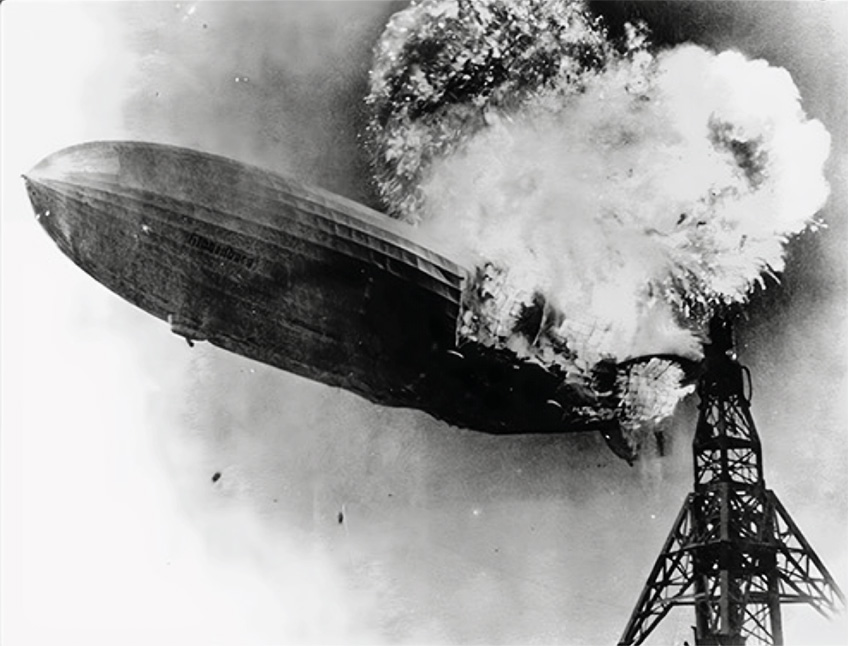
The Graveyard of Airships
The Hindenburg disaster was a killing blow to the future of the rigid airship. The footage from the event burned itself into the public memory for generations to come, and remains emblematic of the era to this day.
Dr. Eckener suffered the first and final mark on his hitherto unblemished Zeppelin safety record. The Military Affairs Committees in both the United States House and Senate invited him and von Meister to offer their thoughts, and Roosevelt’s White House expressed some sympathy to the German plight in view of the disaster. Though the directive would prove premature in light of subsequent events, Berlin had decreed that hydrogen would no longer lift its airships. In response to Eckener, himself no friend of the Nazi regime, and his pleas, Congress passed the Helium Act in September 1937, which enshrined into law that any airship flying to or from the United States must use helium, not hydrogen. And as part of this effort, there was a movement to provide limited quantities of the lifting gas to Germany.
However, this movement would soon prove as doomed as the Hindenburg had been. After Germany annexed Austria in March of the following year, there was a massive public backlash in the US against the proposal to share helium with what was rapidly seen as a rogue nation. Secretary of the Interior Harold Ickes nixed the plan, despite entreaties from both Dr. Eckener and Captain Rosendahl. Ickes justified his position by arguing that in light of these aggressive acts, the US could not afford to send a potential military asset to Nazi Germany.
The cumulative weight of the various rigid airship disasters proved too insurmountable for the American program to continue. What’s more, the development of the Douglas DC-3 airliner, nicknamed the “flying boat,” demonstrated that practical, comfortable, transatlantic airplane travel was not only possible, but would continue to advance, thereby negating the airship’s greatest advantage. Airships still had potential value as aerial carriers, but there was little real enthusiasm for constructing them in the US. Another large airship project, the ZRN, was proposed in 1938, but the proposal died by 1940 with little to show for it.

The Los Angeles continued to be used in training courses, but was not the focus of these programs; blimps and balloons were prioritized. It was also used for some minor scientific experiments, but its days were fast coming to a close. In 1938, FDR wrote, “The Navy Department does not recommend at the present time the construction of rigid airships. This decision is based on past experience with these airships, and on the fact that, in the opinion of the Navy Department, their scouting missions can be better accomplished at much less cost with long range flying boats.” Roosevelt’s love affair with the rigid airship was absolutely over, 17 years after the initial flirtation.
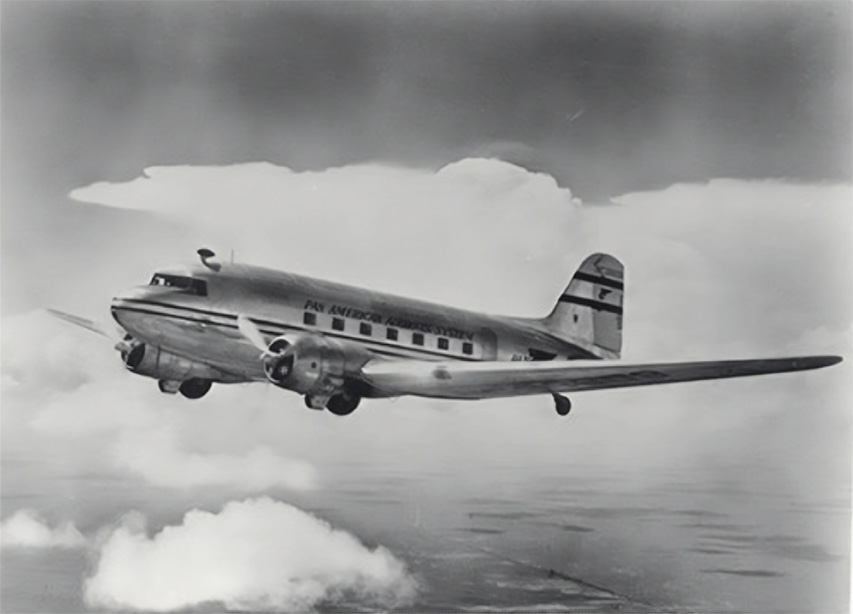
If there was to be a future for airships in the United States, it was in the commercial sphere, not for government or military purposes, but there seemed to be little interest in that anymore. In Germany, another airship was constructed by Zeppelin, the LZ-130, and used for light military surveillance purposes. Despite the nation’s earlier declaration of a hydrogen ban, the LZ-130 nevertheless lifted under the power of that gas due to the dissolution of the US-German helium deal.
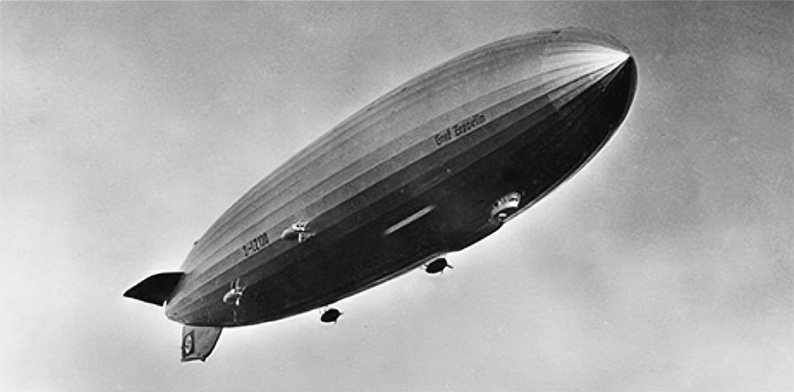
Ultimately, the commander of the Nazi air program, Hermann Goering, decided that there was little to no military value in airships. He ordered that the two remaining zeppelins were to be grounded after the final flight of the LZ-130 on August 20, 1939. Following this, the ships were dismantled along with their hangars.
On the other side of the Atlantic, the Los Angeles was finally ordered to be scrapped in October 1939. On October 24, it was stricken from the Navy List, and was unceremoniously disassembled over the following few months. The project was officially closed on February 29, 1940. By the end of her career, the Los Angeles had logged a total of 336 flights across 4,126 flight hours. It had the longest and most successful career of any US naval airship, and was the only such ship that did not suffer a disastrous fate.
Despite some weak attempts to revive the rigid airship concept, as the US marched closer to the Second World War, it was not to be: airplanes, and to a lesser extent blimps were given priority. As with the First World War, blimps saw some use as antisubmarine patrols during the sequel. In the postwar period, the blimp would be left as the only form of airship operating in the world, with the exception of some experimental hybrid rigid vessels in the 1960s, 1970s, and 2010s, one of which, the Aeroscraft, is still under development.
Rosendahl was poetic in his summation of the airship: “To the layman there is still something almost fantastic, something all but incredible about airships. The very size of the craft, involving an enormous expenditure of time and effort and money, has made its progress slower and magnified the mishaps and failures that accompany every pioneering effort. The dirigible has had to battle its way through seas of doubt and skepticism.”
Throughout the airship era, only 157 rigid airships were built, of which 138 were German, versus 16 British and a meager 3 American ships. This, probably more than any other factor, accounts for why the German Zeppelin had the best service record: continuity, consistency, and a willingness on the part of Germans to fund their development were the key to the success of that program. It is conceivable that, had the US taken the development of the technology more seriously, the history of the airship might have taken a very different course.
Notes: Images from the public domain, National Archives, and HCM archives. Much research for this article comes from USS Los Angeles: The Navy’s Venerable Airship and Aviation Technology by William F. Althoff (Brassey’s, 2004)

An Airship Glossary
- Airship: A flying vehicle capable of lighter-than-air lift
- Balloon: A single-celled flying vehicle consisting of a bag containing some form of lighter-than-air gas or hot air for lift and a container for transport of humans, equipment, or instrumentation (e.g. a weather balloon)
- Blimp: A nonrigid airship consisting of a single gas cell filled with a lifting gas, usually helium; originally a derisive term
- Control Car: An airship component containing engines for propulsion, allowing human control and servicing
- Dirigible: Another term for an airship; alternatively, refers to any steerable device
- Fin: Aerodynamic structures positioned at the rear of an airship or airplane; generally four were used on airships
- Gas Cell: A bag enveloping lighter-than-air gas enabling airship lift; rigid airships contained multiple cells for redundancy purposes
- Goldbeaters’ Skin: A material made from the surface of the large intestine of oxen, used to line airship gas cells due to its impermeability, preventing gas leakage; the term originates for the use of this material in refining goldleaf
- Gondola: A container on the underside of an airship that may contain passenger and crew compartments, the control bridge, doors, and windows
- Helium: A nonflammable, lighter-than-air gas capable of lifting airships and balloons; abundant in the universe, there is a limited supply on Earth
- Hybrid Airship: An airship that combines aspects of nonrigid and rigid ships, with a single gas cell and a more rudimentary keel support structure; also known as a semi-rigid airship
- Hydrogen: A flammable, lighter-than air gas capable of lifting airships and balloons; cheaper, more efficient, and more abundant than helium, but far more dangerous due to the risk of fire and explosion
- Lighter-Than-Air: Term referring either to gases such as hydrogen and helium which are literally lighter than Earth’s atmosphere, or to airship/balloon travel; by creating an impermeable envelope and filling it with lighter-than-air gas, it is possible to lift attached objects into the air
- Mooring Mast: Long poles used to which airships can be attached via ropes or cables
- Nonrigid Airship: An airship lacking an internal support structure and which contains a single gas cell for lift; also known as a blimp, these ships have limitations on their size, volume, and lifting capabilities versus rigid airships
- Rigid Airship: An airship with a lightweight metallic internal support structure and multiple discrete gas cells; these ships, no longer manufactured after the 1940s apart from a few experimental vessels, can be larger and carry more weight than nonrigid airships, but are more expensive and failure-prone due to their greater complexity
- Skin: The outer fabric covering of an airship, stretched taut over either a gas cell or a rigid airship support structure
- Stub Mast: A relatively short mooring mast used to prevent updrafts that can cause airship turbulence when moored to taller masts
- Tall Mast: A standard mooring mast, used before stub masts were developed; have the drawback of leaving airships vulnerable to updrafts that cause turbulence
- Zeppelin: A genericized term for a rigid airship; properly refers to airships produced by the German Zeppelin Company, named for its founder, Count Ferdinand Von Zeppelin
